Posts Tagged ‘Auschwitz-Birkenau’
Friday, June 9th, 2017
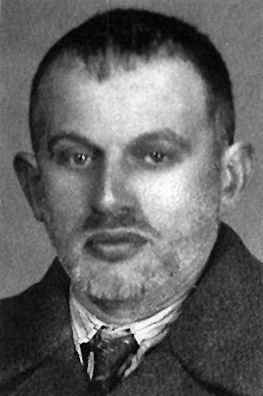
Shlomo Wiesel, Elie’s father, in 1942, a young looking man.
By Carolyn Yeager
Elie Wiesel wrote two ‘official’ accounts of his 1944-45 concentration camp experience: his novel Night (1958) and his official autobiography (Part One), All Rivers Run to the Sea (1995). Thirty-seven years separate these two publications.
Three articles written by me in 2011 (and here) and 2012 contain information that demonstrate conclusively that Night is not a true account of the experience Wiesel may have had with his family at Auschwitz-Birkenau in 1944. Night is written for “effect” and to be a gripping father-son drama that rises to the standards of a literary work of art. Night cannot, therefore, be called Wiesel’s testimony – a claim he made on several occasions.
Because a lot of information was conveyed in these three articles – a lot of details were covered, and I had other purposes in mind – this crucial fact easily gets lost to the reader’s attention. In this article I will zero in on this “crucial evidence” in order to make it crystal clear why Night can only be considered a work of fiction and Elie’s autobiography “All Rivers …” is the place to go for Elie’s ‘true’ account of his experience.
The main evidence I want to put up front is the agreed upon birth date of Elie’s grandmother Nisel Bash Wiesel, mother of Shlomo and Mendel and four daughters. In 1957, Yaakov Fishkovitz filled out a Yad Vashem Page of Testimony (PoT) for his aunt Nisel, stating she was born in 1881 in Chust, Romania and died at Auschwitz in 1944. In 1999, Eliezer Shlomovitz, living in Los Angeles CA at the time, also filled out a PoT for Yad Vashem giving his grandmother’s birth year as 1880, with a question mark. Elie Wiesel never filled out a form for his grandmother, whom he wrote he was very close to, nor for his mother or sister, but only one for his father.
Why Grandma Nisel’s birth date is so important
A birth date of 1880-81 makes Grandmother Nisel 63 or 64 years old in 1944, a figure agreed upon by Hilda Wiesel. However, the story line in Night, accepted as factual by writers, journalists and Internet sources like Wikipedia, gives Father’s age as 50 in 1944, which, if true, would mean grandmother Nisel was only 13 or 14 years old when she gave birth to Shlomo, her third child, and only 11 or 12 at most when she gave birth to her first child. Such a shockingly young age is not in the tradition of Hasidic Judaism to which the Wiesels’ belonged.
In the scene in Night when the family arrives at Birkenau around midnight, Father tells a fellow prisoner who questions him that he is 50 years old and the prisoner urges him to say he is younger. Similarly Eliezer says he is “not quite 15” and is told to make himself older. He subsequently answers “eighteen” when questioned by the guard (or Mengele?). Both men are passed on through. From this, and apparently this alone, the default birth date for Shlomo Wiesel became 1894 and no one, including Elie, ever questioned or corrected that. However, Elie slyly left blank the date of birth on the Yad Vashem PoT he filled out for his father in 2004, and he never offered a birth date for either of his parents.
Wiesel adds 10 years to Father-son age difference in Night
In 1957, Yaakov Fishkovitz also filled out a Yad Vashem PoT for his cousins Shlomo and Mendel Wiesel, giving their dates of birth as 1903 and 1905 respectively. These are probably correct because it makes their mother Nisel age 22 or 23 when Shlomo, her third child, was born, and age 24-5 when Mendel, her fifth, was born.
So why did Elie, in writing Night, make Father 50 years old instead of his real father’s age of 41? Answer: To make the theme of a role reversal between father and son more dramatic, of course. To deepen the loneliness felt by the boy watching his worn-out father break down under the cold, uncaring death machine perpetrated by the evil German Nazis. To write the most heart-breaking story he could!
For the same reason, his 10-year old sister became seven years old and he even made himself a year younger (14 going on 15 instead of 15 going on 16).
It couldn’t be more clear that his purpose in writing Night was different than his purpose for All Rivers, which attempts to give a record of his early life and actual family history. In fact, while Wiesel writes pretty extensively about his grandmother Nisel, who even accompanied the family to Auschwitz in All Rivers – she doesn’t appear at all in Night. He left her out as extraneous to his tightly-constructed narrative, the purpose of which was not to tell it as it really happened.
Summing up
So when the facts diverge between the two books, as they often do, go with All Rivers as the more accurate version. For example, in Night, Eliezer is in the hospital at Birkenau in January 1945 with an infected foot. In All Rivers, he tells the very same story but it is not his foot at all, but his knee that is operated on! If there is any truth to the story, which can be considered doubtful, accept that it was his knee. (I think Elie, or one of his Night editors, liked the dramatic image of leaving a trail of red blood in the snow, so what the heck, just change knee to foot!)
To sum up, Wiesel’s willingness to change important details about his family, and his own major experiences, tells us that creating a “true account” of their year of internment was not his goal. For him, no different from most survivors who write memoirs, he preferred what was “true in his mind.” Or, in other words, what made for a better and hopefully more successful book.
2 Comments
Category Featured | Tags: Tags: All Rivers Run to the Sea, Auschwitz-Birkenau, Buchenwald, Grandma Nisel Wiesel, Night, Shlomo Wiesel,
Social Networks: Facebook, Twitter, Google Bookmarks, del.icio.us, StumbleUpon, Digg, Reddit, Posterous.
Saturday, October 1st, 2016
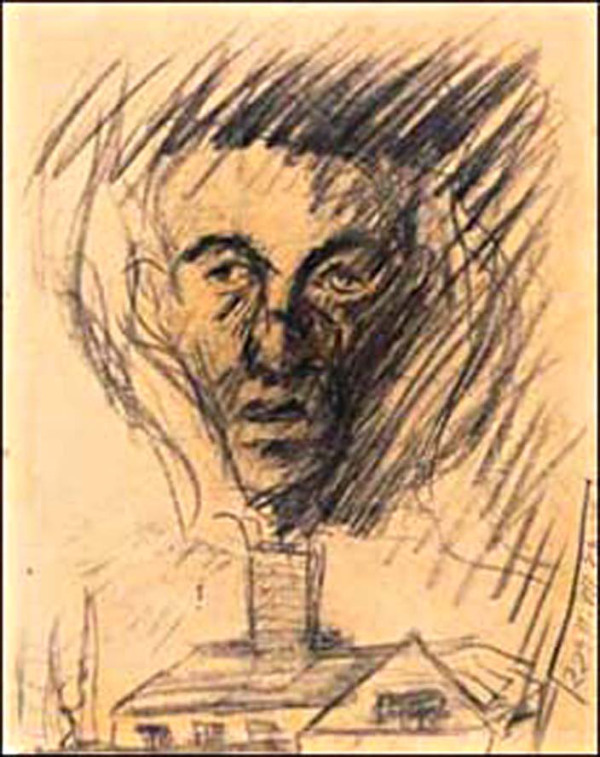
Yehuda Bacon says he drew this ‘portrait’ of his father going up in smoke at Auschwitz when he was 16 years old. He became an artist and teacher, known for his fantastical holocaust images.
By Carolyn Yeager
Bild, Germany’s most popular tabloid, has reported on a new memoir by yet another holocaust surlievor, the “world-famous” artist Yehuda Bacon (not be be confused with Yehuda Bauer of Yad Vashem). Yes, Bacon is the surname of this Orthodox Jewish man, apparently honestly come by in case you’re thinking it’s a bad joke.
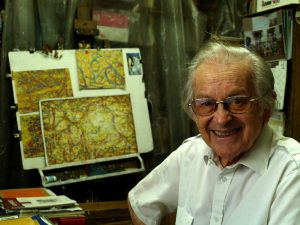
The elderly Yehuda Bacon in his studio in Jerusalem in August 2008 with some of his “world famous art” inspired by the Holocaust.
Bild informs us the memoir is comprised of a series of conversations between psychologist and author Dr. Manfred Lütz and the subject. That means Bacon is not capable of writing it himself. A part was previewed in Bild, and that inspired a hack writer to produce the sensationalized article that appeared in the Daily Mail Online. The Daily Mail is a British tabloid, pretty much the equivalent of Bild in Germany. Holocaust stories are fodder for tabloids – they love and can’t get enough of them.
I’ll start with the Daily Mail – to keep you reading, because there is a lot more to this story. Their headline was “Mengele WHISTLED Mozart as he selected victims for gas chambers, reveals survivor.” Cute, huh? I’m not sure we’ve heard that one before.
It begins: “The callousness of one of Auschwitz’s most gruesome officials has been revealed by a survivor … who was only 15 when he watched his father be taken off to be killed.”
“Mr. Bacon said: ‘He must have loved Mozart, because if he was bored during the selection he always whistled Mozart.’”
Would this 15 year-old even recognize a Mozart melody, let alone be always around when Dr. Josef Mengele was going through the alleged selection process, which supposedly took place often and in various places around the camp? In fact, we are to believe this 15 year old had such a close relationship with this Nazi that he even knew why Mengele whistled. He was bored.
I was more than skeptical of this, but I did find that Bacon may have been one of the teenagers who later dubbed themselves the “Boys of Birkenau” —orphaned boys who allegedly persuaded Dr. Mengele to add them to the “able to work” list. There will be more about this later, showing that Yehuda’s connection with Mengele may possibly have existed, but was limited.
Would he know Mengele’s moods and habits? I’m sure not. But in order to boost his bonafides, Bacon also said of Mengele: “He was always correct, he never beat us children” —slyly implying that others did, or that the doctor might have beat adults. In reality, Mengele was a very kind man whose role at Auschwitz truly was to keep the camp and the people in it free of disease. He did not make all the ‘selections’ that suvlievors attribute to him.
The Daily Mail article was short, it’s purpose only to feature the “whistling Mozart” scenario which supports the popular theme that the Nazis were superficially-cultured barbarians, and German culture is suspect. If you think people are too smart to fall for this, just read the comments following the article. A Londoner wrote: “Oh god, I whistle all the time, never again after reading this …..”
The Bild interview
Turning to the Bild article, they actually write that the 15-year-old Bacon “toiled in the crematoria of Auschwitz.” What? That’s the same thing Bild wrote about Joshua Kaufman! Nonsense, and shame on Bild (though they have no shame). There is nothing said about that in the portion of the interview Bild published. I copy only a couple excerpts.
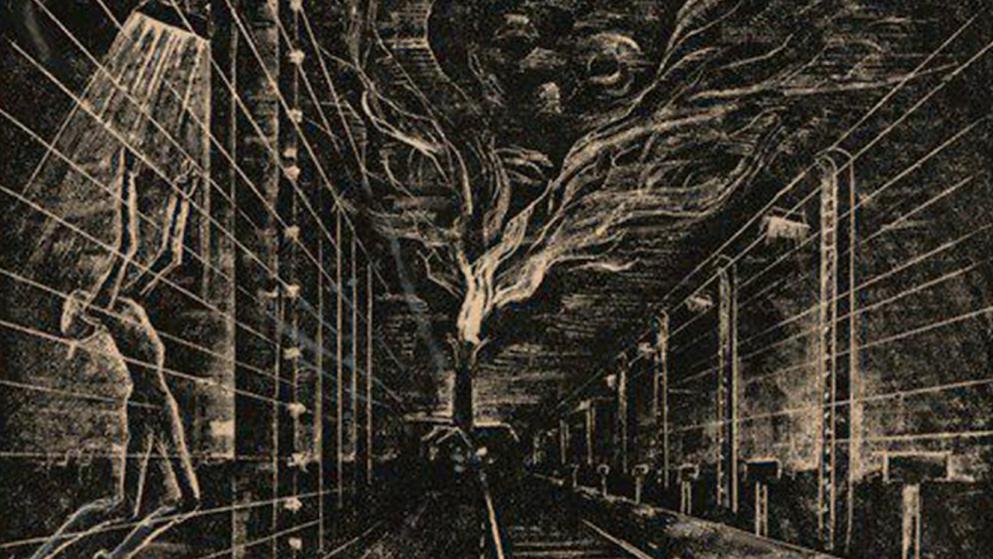
A Yehuda Bacon drawing: Flames pouring out of the crematorium chimney at night, a naked person electrocuted at the fence, and railroad tracks — all standard symbols of the Jewish Holocaust story that have no basis in fact.
Manfred Lütz: How was the end in Auschwitz?
Jehuda Bacon: On night of January 18, 1945 we had to take everyone who was left there. Some tried to hide, because it was clear: This is the end. Now the Russians are coming. We heard the guns from a distance. All had to join in … we even got a loaf of bread for the way and we waited until all were there.
[…]
Then we went out. That I still clearly remember, and exactly as we marched off, the crematoria were blown up. We could still hear these sounds and saw it too. Then we went two or three nights without a break until the Blechhammer camp.
Lütz: That was almost 100 kilometers, day and night, without sleep?
[Me: He was very right to question that. It is not possible to walk in freezing weather without sleep for two or three (which is it? – makes a big difference under those circumstances) nights. What really happened is that they walked at night and rested/slept during the day to keep out of sight of enemy planes.]
Bacon: Day and night without sleep. This is very hard. If you do not eat, if you do not sleep, when it’s so cold, if there is a lot of snow, then one becomes weaker with time. And that is a fight for survival. It’s hard to describe such a fight. But you can, if you have to.
[No, you can’t, for he then describes all those who “were shot because they couldn’t keep going.” In any case, Dr. Lütz lets it pass. Bacon also tells a story of the stereoptype ‘inhuman’ SS officer, similar to what many others have told, including Richard Stashevsky.]
Bacon: Yes. Mauthausen was actually an entirely different stock, it was originally intended for political prisoners. But now it was already half messy here. The remains of Auschwitz came to Mauthausen, but also Hungarian Jews, even from a good background, women with fur coats and all.
I saw the Hungarians who arrived and were still dressed beautifully with rings that had not yet been taken. They gave a ring for a glass of water, so thirsty were they.
And a picture that I cannot forget: There was a trolley on which containers were transported (vessels in which one normally collected waste), and it was a soup, really just water with maybe two potatoes. And now this trolley drives along and it shakes a bit, so this water-soup spills out and the drops flow together with all the dirt in the corner of the trolley. And so a prisoner comes with a small vessel and succeeds in collecting these few drops.
And since an SS man sees it and thinks it is stealing, he takes him and shoots him before a pit.
[Details? Are there any witnesses? Is anyone named? Never. This fictitious event takes place in a vacuum and is therefore a defamation against the SS.]
Bacon also claims the bread was poisoned by the SS, but for what reason I could never figure out. This is the quality of Yehuda Bacon’s “memoir.” Who is this man, Yehuda Bacon?
Yehuda ‘s biography
Yehuda Bacon personifies the show-biz and easy life of holocaust survivorship, living as a “highly praised artist” even though he has no talent and his paintings and drawings are devoid of any artistic merit. Because he was “in the camps” in his youth, he has been able to tell tall tales about what he saw and experienced there, drawing and painting images of “horror” that occurred only in his imagination – afterwards.
Yehuda was born into a Hasidic (Orthodox) family living in the city of Ostrava (Czechoslovakia) in July 1929 – making him 10 months younger than Elie Wiesel, also born into a Hasidic family. Bacon is now 87. Though he has been well-known since 1945, details about his family are missing. His parents are never named, only his sister is given a name—Hanna. Was their surname really Bacon? That isn’t a Czech or Jewish name; it’s actually, as far as I can discover, Germanic-Norman-English, so one wonders what the family name really was and how he came to use Bacon.
His family was sent to the Ghetto Theresienstadt in the fall of 1942 when Yehuda was 13 years old. It was a town southeast of Brno in Moravia that the Germans turned into an experimental “model Jewish settlement” for educated and accomplished Jews. Because of the pleasant living conditions and many cultural activities, holocaust propagandists have invented terrible things that purportedly went on there. A film titled “Terezin: A Documentary Film of the Jewish Resettlement” (translated) was made by the National Socialists showing a comfortable existence within a thriving cultural centre, but most of the film was destroyed after the war. What does that tell you?
Bacon remembers participating in a children’s opera. But in December 1943, the family was moved to Auschwitz-Birkeau, to a family camp. Six months later, according to Yehuda, he was separated from his father, mother and sister. He claims his father was simply taken away one day to the gas chamber, and about the same time his mother and sister were deported to Stutthof camp, east of Danzig, while he remained at Auschwitz. This doesn’t make much sense. But I found what really happened by discovering this newsletter about “Birkenau Boys.”
In early July 1944 there was made a decision about a selection in the camp, which in fact meant liquidation of the family camp. Only 3,500 of the present men and women were then recognized as able-to-work and left that place of death. The rest of the prisoners – old, ill and mothers with children – were to face gas chambers [more of the myth].
[…]
Among them were dozens of boys around 14 and 15 years of age. Then one of them found the courage and asked the camp “doctor” Mengele to choose individuals able to work also [from] among them. Surprisingly, he agreed, and had a crowd of teen prisoners march again. Out of them, he compiled a group of about 90 boys which he then moved to the nearby men’s camp, marked B II d. …
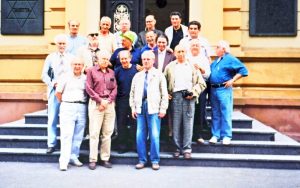
Some of the “Birkenau Boys” gather for a reunion in Terezin – the former Theresienstadt ghetto. Is that Yehuda Bacon in the middle front?
The boys were placed in the men’s camp in Block 13, known as a criminal block. The prisoners there – Poles, Germans, Russians – were under a tightened regime and got harder work. Czech boys drew attention there, however the block supervisor did not limit their activities much; they played football or sang together Czech songs. […] Their days were mostly filled up with work – they helped in the kitchen, brought from outside [the camp?] things needed to repair roads or heat houses. Some of them even worked outside the camp.
After a few weeks a selected group of “able” boys was sent to work in the Reich.
But not Yehuda – he remained until the evacuation. He was probably small and slight, and maybe in some other ways not fit. His father, mother and sister, being capable of work, were sent to other camps to work in the vital munitions factories. On Bacon’s Wikipedia page, it says he “saw his father murdered in the gas chambers.” This, of course, is the type of big, fat lie he’s always told.
The story of his liberation
Bacon claims the “death march” he was on from Auschwitz began on January 18, 1945. All it amounted to was a 2-day walk to Blechhammer, then several days of rest, and he boarded a boxcar train to Mauthausen, where he obviously was not killed. In spite of the fact that he appears to have been useless, he continued to be fed and housed by the Nazis. In early April, he was moved to Gunskirchen, a sub-camp 50 kilometers away. It was there he says he and another boy just walked away one day and met up with the US Army on May 5th. He was taken to a hospital in the town of Steyr, after which he went to Prague but could not find his family members. From there he went to France (perhaps to the Jewish Orphans Home where Elie was?) and then Israel, where he studied painting, drawing and graphics and eventually became a professor in Jerusalem. A miracle for sure, since he cannot draw. His paintings are said to “translate the Holocaust artistically” and today “hang in the Yad Vashem and the US Congress.”
The “art” of Yehuda Bacon
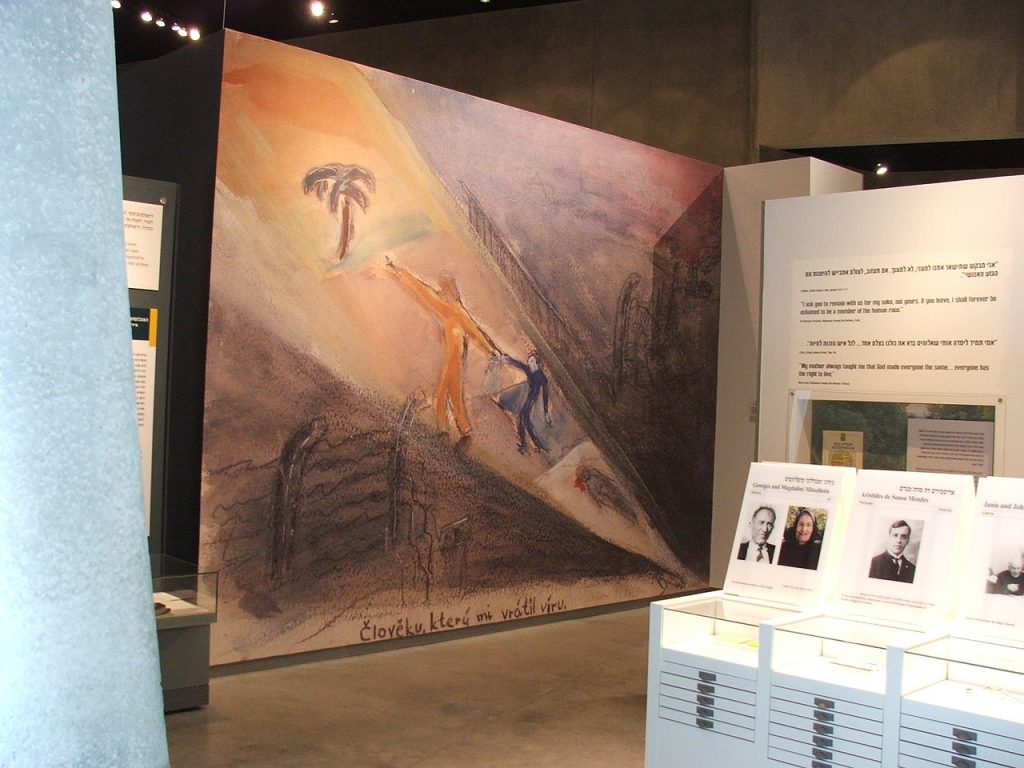
The mystical, magical, miraculous nature of surlievor tales is epitomized in this greatly enlarged reproduction of a much smaller Bacon painting installed in the Yad Vashem museum in Jerusalem. The primitive style is that of a self-taught amateur.
To cover for his lack of any talent for his chosen profession, things like this are written about his work.
His Œuvre consists of a synergistic interaction: on the one hand, Bacon processes the experiences of his childhood and youth in the concentration camps, on the other he is searching for a way of understanding through his art.
Such is the way Jewish critics cover for bad Jewish art, but Bacon is particularly only a holocaust promoter, creating primitive and ridiculous depictions of fantasy. Most of his ‘works’ are very small, too; measured in centimeters. Of special interest, he is the one who drew the “gas chamber” interior that I reproduced in my book Auschwitz: The Underground Guided Tour. These meaningless lines cannot be from memory, but he was told what it was supposed to contain. What a fraud.
You can see more of Bacon’s Œuvre here. (Sorry it’s been taken down.) His Facebook page is here.
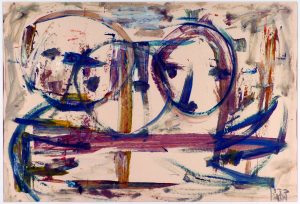
Typical Jewish art by Yehuda Bacon.
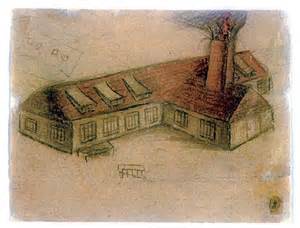
Tiny, crude drawing of a crematorium/’gas chamber’ with fire-belching chimney by Yehuda Bacon. -Yad Vashem collection
7 Comments
Category Featured | Tags: Tags: "Holocaust survivors", Auschwitz-Birkenau, Yad Vashem, Yehuda Bacon,
Social Networks: Facebook, Twitter, Google Bookmarks, del.icio.us, StumbleUpon, Digg, Reddit, Posterous.
Sunday, June 26th, 2016
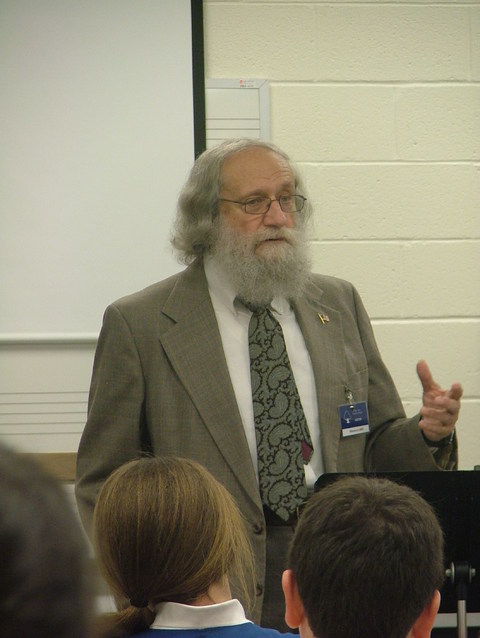
Psychological terrorist Joseph Hirt speaking to 7th grade students (age 13), filling their heads with horrible lies with the blessing of school teachers and administrators. He was never vetted to find out if he was qualified to influence impressionable youth. Shameful carelessness !
BY CAROLYN YEAGER
The mainstream accounts of Joseph Hirt’s “confession” are showing up everywhere, but they mistakenly report it as Hirt “coming clean” about his lies. Not true. Hirt didn’t just lie about being in Auschwitz, he lied about many of his experiences during the “Holocaust” in general, and continues to do so. And really, how can you expect a man who claimed he saw Adolf Hitler turn his back on Jesse Owens at the 1936 Olympics (when he was 6 years old and living in Poland) to be a man you would ever trust to tell the truth? Particularly on this subject. This is only common sense – a universal human trait that has been made illegal in almost all of Europe, and socially condemned everywhere else because it is a threat to the “holy holocost” religion. But common sense is what I will be using in this article to show the pure hatefulness and falsity of the stories Joseph Hirt has been telling Pennsylvania school children for 15 years already.
As I wrote earlier, New York history teacher Andrew Reid did a knock-down, bang-up job in scaring the daylights out of old Joseph Hirt, threatening him with investigations of forgery, fraud and identity theft if he didn’t come clean and admit his Holocost survivor claims were false. After some initial resistance, the cunning 86-year-old realized his game was up and he needed Reid as a friend, not an enemy. Hirt composed a long letter and made it public by sending it to a newspaper. It is now posted at Scribd. for all to read. It’s clear from this letter that he is not sorry for what he did, he is only sorry he was caught and couldn’t wiggle his way out of it with a man of principles like Reid, who did a commendably thorough job. The letter is a combination treatise about the horrors of the Holocost, his personal life story, and a few paragraphs stating he was wrong to “insert himself into the picture” at Auschwitz, but he only had the best of intentions. He asks for forgiveness.
Hirt appears to me as an intelligent, educated man whose self-absorption developed into an obsession with “The Holocaust,” reading many books and surlievor stories about it. His counsel to the 6th through 12th grade students he’s spoken to for so long is to “keep the truth and the memory of the Holocost always in your heart and mind.” Is that good advice? The kind you’d like your children to receive in school? Hirt is convinced he’s turned many into lifetime believers and upholders of the holocost myth, and says that is his goal.
He begins the letter with an overview of what the ‘Holocaust’ was — his own condensed version of the official Jewish narrative — intended to bolster his claim to having the “best of intentions.” His intentions are to prevent it ever happening again … but did it happen the first time? He begins:
The Nazi Holocaust refers to the W.W. II concentration camp system used for the extermination of about six million Jews and about five million non-Jews by Nazi Germany.
False. The camps were not for extermination at all but for separating the perceived disloyal, harmful and or criminal elements from society, just as prisons everywhere. How does he explain that over half a million European Jews received lifetime payments from Germany if the plan was to kill them all? There were the same number of Jews in the world after the war as before – just in different places. Why were Jews still living in Berlin at the end of the war? Did the murderous Nazis forget about them? Why were there millions of displaced persons in Europe after the war? And why was his hero Primo Levi put in the camp hospital at an alleged ‘death camp’, Birkenau, and left there to await the arrival of the Soviets? He could easily have been put to death. There were also 600 or so children in that camp when the Soviets arrived, being well taken care of by Polish women. There is no proof of extermination at all, only assumptions based on a desire to punish Germany and exculpate the Allies.
The killings took place in specially constructed camps, most located in Poland, The victims were herded into cattle cars and transported to the camps. After days on end en route or standing unattended along the way without food, water, or medical care, many died.
Not at all. He can’t just generalize “camps” and make vague references to “days on end”. Transports to Auschwitz-Birkenau were at most two days in length, there was water in the rail cars, they brought their own food, and no one died en route. Many Jews were taken to their destination in passenger cars. Later on, in 1944, available trains were scarce.
On arrival at certain camps the victims were told to undress for showers, but were led instead to rooms where they were gassed to death. Bodies of men, women, and children were removed by specially assigned prisoners whose working units burned them—first in open fires, and later in crematoria built for that purpose.
Really, where is he talking about?! “Certain camps?” He’s afraid to name them lest he can then be proven wrong. “Were gassed to death in rooms” on the pretext of taking a shower? This has been convincingly debunked as atrocity propaganda. Then “burned in open fires.” Did he ever see such a thing? Of course not. No one has. And it doesn’t work either, humans don’t burn that easily. Hirt takes all this from books he has read, books by Jews, every one of them the result of rumors and motives of tribal revenge.
Sometimes inmates were deliberately starved. Those who became weak or ill were sent directly to be gassed. Some were killed in camp hospitals by injection directly into the heart. Others were hanged, beaten, or suffocated in tiny airless cells. Both planned and spontaneous brutality played a role in the treatment of inmates. They were ruled by other inmates, often former criminals imported from actual prisons, who imposed their rule by degradation, mutilation, and torture.
I categorically deny that any inmates were deliberately starved in any German/SS-run camp at any time. There is zero evidence of that except for tales told by surLIEvors, always based on what someone else said, never anything they saw or experienced first hand. Because victims of typhus (and some other diseases ) rapidly lose weight and body tissue, and become “skin and bones,” photographs of these victims have been used to accuse the camp authorities of deliberately starving them. The idea that inmates were kept on a starvation diet is completely false. The same goes for importing criminals from civilian prisons to boss over the camp inmates. The fact is, there were actual lawbreakers in some of the camps because they had been assigned to serve out their prison term there. But partisans and communists were pretty nasty dudes too. Any of the rare hangings that did take place were for cause, after the accused was found guilty of a serious offense. Injections through the heart is a rumor that has never been proven. Other camps were solely industrial labor camps for producing war munitions and other wartime needs, like the Auschwitz complex. I have yet to see any evidence that anyone suffocated in tiny airless cells, and I have studied it and written about it.
Certain camps combined labor and extermination, selecting incoming prisoners for one category or the other; the selections at Auschwitz were infamous. Those deemed capable of work or considered useful in (cruel) experiments were assigned to quarters in the camp. Others were immediately taken to the gas chambers. Families were separated forever in this process.
By describing the Holocost in such amorphous terms and dislocating it from the war, by using photographs doctored in the intelligence laboratories, by having the help of the major media outlets and Hollywood—that is how they succeed in keeping the public believing. (Not to mention indoctrination in schools to unprotected, inexperienced children, with fakers like Joseph Hirt coming to visit regularly.) And sorry, there were no cruel experiments being carried out – not even by Dr. Mengele! It is the writers of the surlievor books who have made “the selections at Auschwitz infamous.” In reality, at that place, those who could not work—all those women with children and elderly people—went to Birkenau with it’s numerous barracks where classes and programs, music and theater productions were available to help them pass the time. Some worked in the kitchens and the medical facilities. There were family sections for gypsies and other groups who were not desirable as workers. No one was exterminated. There were no homicidal gas chambers anywhere in the camp, only buildings for gassing clothing and mattresses.
Information about concentration camp behavior exists because of the sharing of details by a relatively small number of inmates who managed to survive. Soon Holocaust memories will be held entirely by those who were not there!
This is painful for him, the fear that “the Holocaust” will lose its power and influence without real surlievors to talk about it as eye-witnesses. But he admits it’s a small number who have given us these details. Not because the rest were killed but because not every camp inmate wants to lie about it, and the true story cannot be published. Jews own all the publishing companies. Plus, anyone who writes a different story is attacked and ostracized, Jew and non-Jew alike. We know now that Joseph Hirt was not there, but he added his voice anyway by copying what the others wrote. Who did they copy from?
“But whoever closes his eyes to the past becomes blind to the present. Whoever does not wish to remember inhumanity becomes susceptible to the dangers of new infection.”
This is said all the time, but it is false; it is sophistry. Plenty of humans, billions of them, have lived perfectly well in the present without knowledge of the past. Most humans make the same mistakes over and over again, and knowledge that we did it before doesn’t stop us from doing it again. Real learning comes only from an individual’s own personal experience, not from being lectured to. The world would be much better off if the holocost went down the memory hole.
I am seeking help from my pastor, who knows my heart and my intent. I am also consulting with a mental health professional to try to understand how I swerved off in my presentations in a direction that should not have been taken.
The pastor and the mental health professional is something Andrew Reid insisted on, but in fact, before his retirement, Hirt was employed as a school mental health professional himself, so he knows how the human psychology, especially in young people, works. I don’t see any change, in this letter, in his attitude that he is an expert on Holocost and should be listened to as an expert.
Primo Levi
Hirt writes that he admired and was very influenced by Primo Levi; he read all Levi’s books and writings that were Holocaust-related. He modeled his own fabricated story on Primo Levi’s. It was Levi’s Auschwitz number, 174517, that Hirt had tattooed on his own arm – “as a symbol and way of remembering him” he says, except he got one number wrong. However, in the schools he passed the number off as his own! Of course, he was never questioned — that would be unthinkable!
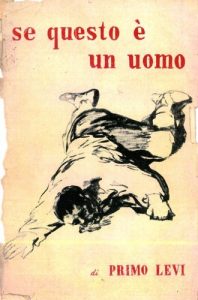
Original cover of Primo Levi’s book in Italian, published in 1947.
Levi was an Italian Jew with a chemistry degree who spent 11 months in Monowitz where he worked as an assistant in IG Farben’s Buna Werke laboratory. Though he had a cushy indoor job, he complained about everything he could think to complain about in his book If this Is a Man (shown right) which he wrote in 1946. A German translation was published in 1961 in which he addressed the German people in a special preface written out of his need to remind them what they had done! (From his book of essays The Drowned and the Saved, Einaudi publishers, 1986, 170 pages)
In If This Is a Man, Levi alludes to “the gas chambers of which all speak” (p.49) but evidently he has neither seen nor met anyone who has seen these things. Then he asks “Is it true what one hears of selections, of gas, of cremation?” and he is answered only with a rumor that persons in the Infirmary who were in decline, who were not going to recover, would be sent to the ‘gas chamber.’ (p.46) That is the extent of Primo Levi’s knowledge of ‘gas chambers’ after one year at Monowitz.
Shortly before the Soviets arrived, Levi came down with scarlet fever and was hospitalized. Not being recovered enough to go on the march to the West, he was still there in the hospital attended by a Jewish doctor when the Soviets “liberated” the abandoned Auschwitz-Birkenau camp.
To be continued in Part 2
6 Comments
Category Featured | Tags: Tags: Andrew Reid, Auschwitz tattoos, Auschwitz-Birkenau, gas chambers, Holocaust fraud, Monowitz, Primo Levi,
Social Networks: Facebook, Twitter, Google Bookmarks, del.icio.us, StumbleUpon, Digg, Reddit, Posterous.
Sunday, June 19th, 2016
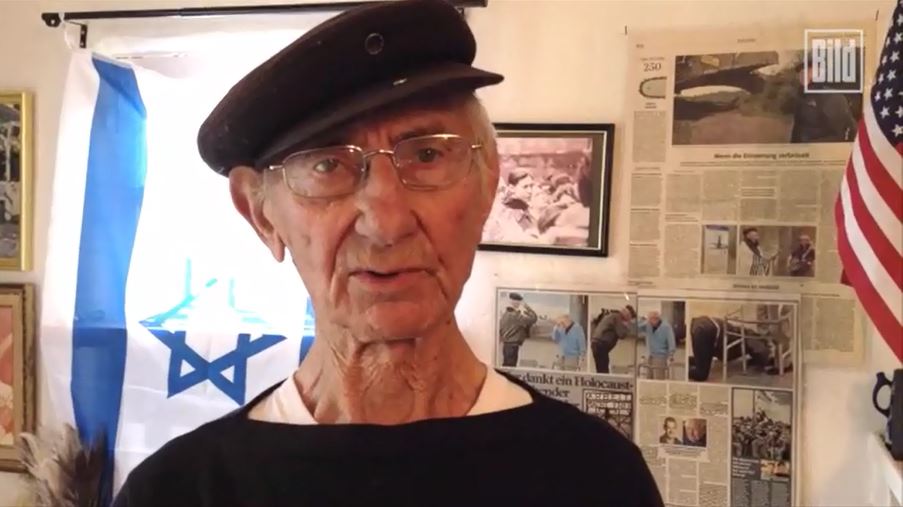
Zionist Joshua Kaufman in his home in the Los Angeles area of southern California, surrounded by two national flags and the news stories that gave him recognition pinned to the wall behind.
BY CAROLYN YEAGER
Like Joseph Hirt, who is a complete fraud, Joshua Kaufman has now been proven to be at least half a fraud. The number he claimed to be his when he told NBC News, “I am not Joshua Kaufman, I am number 109023” belongs to Mateusz Judasz, born September 12, 1901 in Łaznów, Poland. [Note: It has been discovered, on 7-5-16, that the number Kaufman gave to NBC when speaking about Auschwitz was his Dachau prisoner number. Keep that in mind as you read this article.]
A search in the Auschwitz-Birkenau State Museum online records revealed that Judasz arrived at Auschwitz on March 18, 1943 (over a year before Kaufman allegedly did) and was assigned the number 109023. His profession is listed as “farmer.” He was transferred to Mauthausen (in the Ostmark) in that same year and was eventually liberated from Mauthausen.
For those who demand more in the way of proof, here it is copied from http://www.auschwitz.org/en/museum/auschwitz-prisoners/ (type in name)
Main page > Museum > Auschwitz prisoners
Auschwitz prisoners
Judasz, Mateusz
(prisoner number: 109023)
born: 1901-09-12, place of birth: Łaznów, profession: farmer
Fate:
1. 1943-03-18, Auschwitz, arrived to camp
2. transferred in 1943 to KL Mauthausen, liberated,
Sources:
1. Memorial Book Radom
Consider that the above information on Mateusz Judasz was carefully recorded and kept by the SS who ran the camp. Consider too, that he is probably one whom Jews claim to have been “gassed” shortly after he arrived at Auschwitz. I can just hear them: Von day our friend Matty disappeared. Ve learned from de talk around de camp dat evil Dr. Mengele sent him to da gazz chamber. Oy vey. Ve recited a Kaddish.
Looks like Kaufman should have checked with Auschwitz about the number he selected, but he was sooo confident after the staged reunion went so well and he was featured on a double-page spread in the Daily Mail [*more on that below]. He followed up a year later by crashing the Reinhold Hanning murder trial in Detmold, Germany – and that is where his hubris may have done him in. He made rash claims about his experiences in Auschwitz and Dachau, including announcing his Auschwitz prisoner number as 109023.
I can also tell you that the name Joshua Kaufman was not found in the Auschwitz-Birkenau database, however the Museum reminds us that “the Nazis destroyed most of the documents they created” and that a list with the names of all Auschwitz victims does not exist. Okay, so maybe he was there but his records were destroyed. If so, he would have been given a number. Since we now know the number 109023 belonged to someone else, logic tells us he wouldn’t have used that number if he had one of his own. If he lied about this, then he lied about working in a gas chamber, removing dead bodies and taking them to the crematorium. (Of course, we knew that but it’s good to have it confirmed.)
So here is what has now been definitely determined regarding Kaufman’s story:
1) He lied about his prisoner number
2) He lied about working in a gas chamber in Auschwitz (he was never asked which one) and about being 15 years old at the time.
3) He lied about throwing fellow prisoners in a cement mixer at Dachau.
4) He lied about having to carry 50-kilo bags of cement for more than 12 hours a day.
At this point, we can only wonder what else he lied about. Maybe saying he was a “living corpse” when Dachau was liberated? I somehow don’t believe that.
*The Kaufman-Gillespie “reunion” was arranged by a TV crew
It turns out the Daily Mail received the story and photos from The History Channel Germany, the outfit that dreamed up and arranged the “reunion.”
I had already made the connection that the double page spread in the Daily Mail was published on Jan. 21 to coincide with the Jan. 27, 2015 Day of Commemoration for Holocaust victims, recognized annually at Auschwitz-Birkenau and at the United Nations. Every year, these institutions and the greater media look for (or create) holocaust-related stories to coincide with this commemoration. Because 2015 was the 70th anniversary of the so-called Auschwitz liberation, it was more important than usual to create as much fanfare as possible.
And that is how it came about that Joshua Kaufman, who no one had ever heard of, had such a well-publicized reunion with one of the U.S. Army “liberators” of Dachau, Daniel Gillespie, just prior to the 70th anniversary. I have learned that The History Channel Germany discovered (how is not explained) that these two “survivors” from Dachau lived close to one another in Orange County, CA. Do they have access to concentration camp archives in order to discover these things? I suppose so. The History Channel is one of the prime outlets for WWII and ‘Holocost’ indoctrination for the Holocaust Industry.
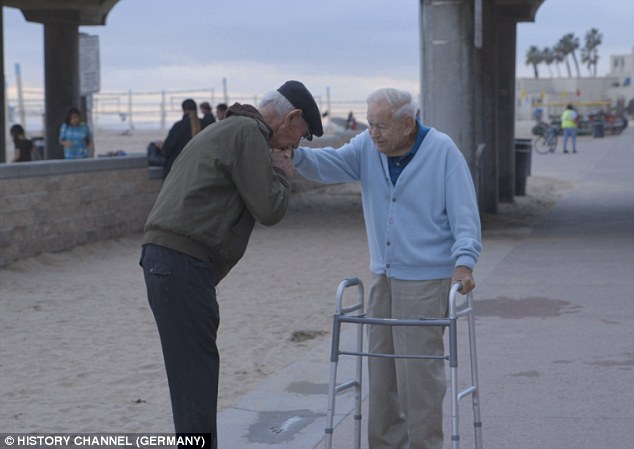
A still from the film documentary made at Huntington Beach, CA of the “reunion” of a Dachau survivor and a Dachau liberator. This appeared in the Daily Mail and other newspapers. Notice the photo credit on the lower left to “HISTORY CHANNEL (GERMANY).
So The History Channel peddled the story to the Daily Mail and other news outlets in exchange for the promotion of their then-upcoming TV documentary. You can see the photos at the Daily Mail are credited to “History Channel Germany.” On another site, the same photos are credited to “Dirk Heuer, HISTORY Germany.” The photos in the Bild newspaper layout of Kaufman at home are credited to Nancy Pastor/Polaris Images, who was probably hired locally. Quite a bit of preparation is behind a feature story like this, and this reunion was surely not a spontaneous happening.
I first noticed that the reunion was arranged by The History Channel Germany in this CBS-LA news story. All I could find in a search for THCG was this story. What I didn’t ever see is any mention of the U.S. Army or any official historical associations being involved with this ‘reunion.’ It was purely a commercial enterprise.
The CBS-LA reporter wrote this:
The History Channel Germany arranged the reunion for a documentary that aired last year
[…]
in January 2015, a German documentary team discovered the two were living within an hours’ drive. When they met on a Southern California beach, they talked about the war, and survival.
CBS and other major media were invited to cover the reunion. It was not a private affair, it was a staged event. The Huffington Post also picked it up and ran a story on Jan. 26, 2015:
The meeting was arranged by director Emanuel Rotstein, and will be featured in a documentary, “Liberators of Dachau,” according to a press release from the History Channel.
Emanuel Rotstein – that name tells us a lot about the purpose of the project and the reliability of the research backing it. Another report puts it this way:
The two men were reunited by a television crew for a documentary they were making called Dachau Concentration Camp – The Hour Of The Liberators. It first aired on the History Channel on May 31st, 2015.
Another question that arises is: did the United States Holocaust Memorial Museum (USHMM) play a role in this? I bring them up because it turns out that both Kaufman and Gillespie were special guests at the USHMM 2015 Los Angeles Dinner just two months later, on March 16th. That had to be because of The History Channel documentary, for which heart-warming story they were feted at the Dinner. Two months after that, Gillespie died.
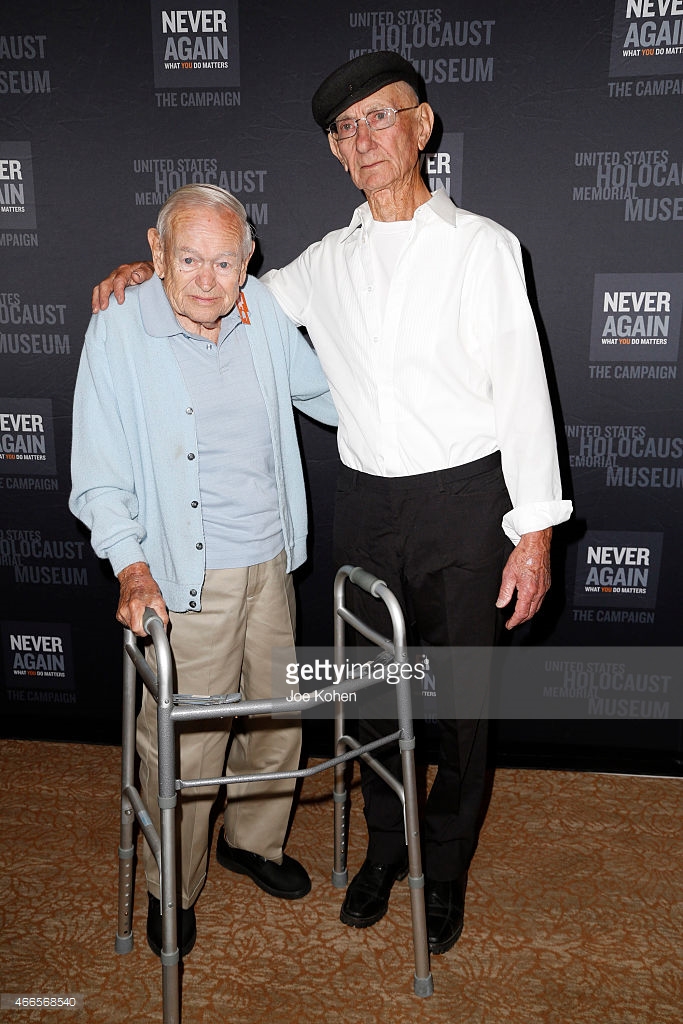
The caption at the Getty Images web page reads: Holocaust Liberator Daniel Gillespie (L) and Holocaust Survivor Joshua Kaufman attend the United States Holocaust Memorial Museum 2015 Los Angeles Dinner at The Beverly Hilton Hotel on March 16, 2015 in Beverly Hills, California.
The following spring, Joshua Kaufman created another splash when he traveled to the Reinhold Hanning trial in Detmold, Germany with two of his daughters. This time there was a big write-up in Bild, Germany’s popular tabloid newspaper, and scores of U.S. news outlets. Kaufman was denied his request to testify at the trial and, since then, I haven’t found more about him.
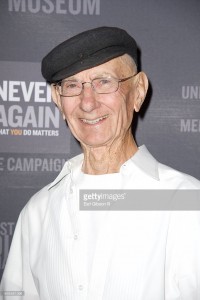 I write this to clue you in that it’s all Shoah Business. Whether Kaufman is the exact frightened prisoner Gillespie said he helped out of the latrine (this contradicts Kaufman’s statements that he “became an animal” in the camps, a violent animal who could throw other prisoners into the cement mixer), neither of them offers any material evidence to prove that. We only have their word for it. We also now have a biased television documentary directed by a Jewish-German named Rotstein (Redstone). None of this inspires confidence that it is anything more than another “heart-warming” holocaust tale to satisfy the voracious appetite of the Holocaust Industry and Holocaust public. Why be concerned about the truth of it when it’s such an inspiring human interest story.
I write this to clue you in that it’s all Shoah Business. Whether Kaufman is the exact frightened prisoner Gillespie said he helped out of the latrine (this contradicts Kaufman’s statements that he “became an animal” in the camps, a violent animal who could throw other prisoners into the cement mixer), neither of them offers any material evidence to prove that. We only have their word for it. We also now have a biased television documentary directed by a Jewish-German named Rotstein (Redstone). None of this inspires confidence that it is anything more than another “heart-warming” holocaust tale to satisfy the voracious appetite of the Holocaust Industry and Holocaust public. Why be concerned about the truth of it when it’s such an inspiring human interest story.
11 Comments
Category Featured | Tags: Tags: Auschwitz-Birkenau, Dachau, Daily Mail, Daniel Gillespie, Huffington Post, Joshua Kaufman, Mateusz Judasz, The Hstory Channel Germany,
Social Networks: Facebook, Twitter, Google Bookmarks, del.icio.us, StumbleUpon, Digg, Reddit, Posterous.
Sunday, May 22nd, 2016
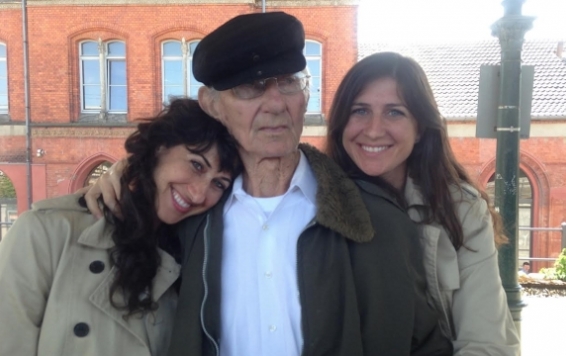
Joshua Kaufman poses with his daughters Alexandra (left) and Rachel in front of the Chabad building in Berlin, after leaving the show-trial in Detmold. (photo from Jewish Journal)
By Carolyn Yeager
That’s not asking too much. He burst on the scene (with the help of Bild news organization) of what is already a show-trial in Detmold, Germany and made it even showier. He sought attention for himself.
He is quoted by NBC News as proclaiming in the courtroom, referring to Auschwitz
“Can you imagine working in a crematorium, when you are only 15 years old? I had to break the bones of the dead to get them untangled … I am not Joshua Kaufman, I am number 109023.”
[Note: It has been discovered, on 7-5-16, that the number Kaufman gave to NBC when speaking about Auschwitz was his Dachau prisoner number. Keep that in mind as you read this article.]
I think, under the circumstances, this statement requires him to tell us if he has this number tattooed on his arm. He sought publicity for his story of being a victim of Auschwitz – no one dragged him into that courtroom as they dragged Reinhold Hanning, the defendant. He can’t selectively say what he wants and hold back what he doesn’t want to say. Plus most of his fellow Auschwitz deportees willingly show their tattoo – those that have one, that is.
I have explained elsewhere that according to the bits and pieces Joshua Kaufman has thrown out there (not in any chronological order, by the way), he cannot have had the Auschwitz number 109023. According to the Auschwitz-Birkenau Museum web site, as a Hungarian Jew arriving at Birkenau in 1944, his number would have been preceded by an ‘A’ followed by a number no higher than 20,000. The number he gives is over 100,000. Because of this discrepancy, which he himself originated, he is responsible for answering how he came up with this number.
A second problem with this statement is that it can be shown he was 16 years old when he would have been in Auschwitz in 1944. Yet he even says he was 15 at Dachau, in 1945. It appears he has chosen the age of 15 for his victim story because it has a better ring to it than does sixteen.
A Media Creation
The media won’t ask such a question or bring up any discrepancies. The Joshua Kaufman story is a media creation. Beginning with the Daily Mail UK‘s trumped-up January 2015 story about a reunion with his American “liberator,” then moving on to Germany’s Bild and it’s before-and-after arrival video, plus the US’s NBC News coverage in the courtroom with Kaufman, it is media creating the news. Yet with these three major news outlets covering the man’s story, we still know practically nothing of substance about Kaufman. All they give us are a few outrageous lies (like the one quoted above), and ‘human interest’ profiles.

A Bild photographer took this picture of Kaufman’s home and work van when a team visited him in California before he even left for Germany to crash the show-trial of Reinhold Hanning. Note Kaufman walking toward his front door.
Here are some things I’ve learned about him from carefully scanning the news articles:
1. He comes from Hungary, born in 1928.
2. He was a “survivor” of the Debrecen ghetto.
3. He was deported to Auschwitz (probably in 1944), then worked in 3 smaller camps, ending the war in Dachau where he was liberated on April 30, 1945.
4. He moved to Israel at an unknown date after the war, stayed there for 25 years (some sources say 30 years) and served in the IDF during two wars in 1967 and 1973, then moved to the United States before 1975.
5. He married at age 47, which would have been in 1975, and had a family of four daughters.
6. He worked as an independent plumber in California.
7. He never talked about his holocaust experience until recently because [he said] he felt guilty about throwing fellow Jews into cement mixers. He’s talking about it now because he says, “In ten years’ time, there will probably be no one left who survived it.”
So let’s start with number one and two:
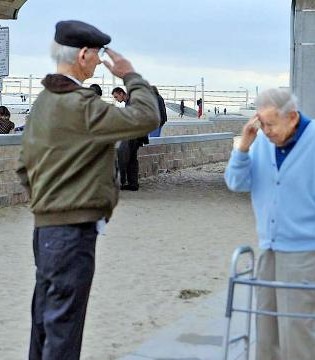
In this cropped photo from the Daily Mail picture layout in January 2015, we can see Kaufman is wearing the exact same clothes he wore in May 2016 at the trial in Detmold, and in Berlin, above.
Kaufman says he is 88 years old in May 2016 which gives him a birth date of 1928. It was his “liberator” Daniel Gillespie (in photo at left) who identified Kaufman to the Daily Mail as a Hungarian Jew. Bild reinforces that by writing that he was a survivor of the Debrecen ghetto:
Kaufman survived the Debrecen ghetto (Hungary). He also survived the Auschwitz and Dachau concentration camps. In Dachau, he was freed on 30 April 1945. Following his liberation, he lived in Israel for 25 years. Kaufman: “In the concentration camp, I was no longer a human being, but an animal. Aged 15, I had to carry 50-kilo bags of cement for more than 12 hours a day. Everyone who could not manage that was thrown into the cement mixer.
Does anyone at Bild really think that exhausted workers were thrown into the cement mixer? I doubt it, but not a questioning word is heard. Checking out the Debrecen ghetto, I found this on Wikipedia:
The order to erect a ghetto there was issued on April 28, 1944. They finished building the ghetto walls on May 15. On June 14 all Debrecen Jews were deported to the nearby Serly brickyards. Most of the Debrecen Jews were deported to Auschwitz, arriving there on July 3, 1944.
The Debrecen ghetto was only used for one month before they were deported to Auschwitz. Kaufman, being among them, wouldn’t have arrived until July 3, 1944, and spent only 10 months at various camps. Or, he never left Hungary at all.
Debrecen was liberated by the Soviet Army on 20 October 1944. Some 4,000 Jews of Debrecen and its surroundings survived the war, creating a community of 4,640 in 1946 – the largest in the region. About 400 of those moved to Israel, and many others moved to the west by 1970.
Considering he doesn’t say when he was arrested, or what he did immediately after liberation from Dachau, he could very well be one of the 400 who moved to Israel from Debrecen and then to the United States in the 1970’s. But, in any case, his alleged Auschwitz number doesn’t fit his history, as far as we can know it. More on that in a moment. First I want to include some history of Debrecen, Hungary’s second largest city, from Wikipedia:
Jews were first allowed to settle in Debrecen in 1814, with an initial population count of 118 men within 4 years. Twenty years later, they were allowed to purchase land and homes. By 1919, they consisted 10% of the population (with over 10,000 community members listed) and owned almost half of the large properties in and around the town
In 100 years they went from 0 to 10% of the population, from 118 to 10,000, and owned 50% of the large properties. This is why they were and are resented. The mistake came when they were given the same rights as Hungarians by being allowed to purchase land and homes anywhere. If individual Jews are not wealthy themselves, they get money from Jews who are wealthy, even abroad, and buy up everything they can as their agent. So the Hungarians were glad to get rid of these Jews when they were deported — not to a death camp but to a labor or detention camp.
At that time, in 1944, Kaufman was 16 years old. He has shown pictures of himself in the Bild video in which he appears to be a well-to-do Jew, both before and after his “ordeal.”
More on Kaufman’s history
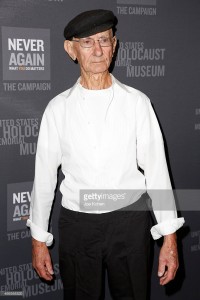
Lookee here. Now-”famous-holocaust-survivor” Joshua Kaufman attends the United States Holocaust Memorial Museum 2015 Los Angeles Dinner at The Beverly Hilton Hotel on March 16, 2015 in Beverly Hills, California. The big layout in the Daily Mail appeared only two months earlier in January 2015. He became a star.
Of numbers 3 through 6, I have no further information than what is stated.
Number 7 tells us that Kaufman’s objective is to help the Jewish case for “The Holocaust,” just like Martin Gray, Elie Wiesel and Paul Argiewicz, and hundreds of others. It’s not about reality but about what’s good for the Jews. Kaufman jumps right into it.
“I lost 100 members of my family, At age 15, I was working in a gas chamber in Auschwitz, dragging out bodies.”
If he became a “sondercommando” working in a gas chamber, he would certainly have been tattooed. Bild newspaper was even told that he had to transport the dead bodies out of the gas chamber with a wheelbarrow. “In Auschwitz, Kaufman had to transport the dead bodies out of the gas chamber with a wheelbarrow. He will talk about this during the trial,” they wrote. A wheelbarrow!? Excuse me, but I have to laugh at that. With 20,000 allegedly gassed per day at that time, you would need a hundred people like him, all bumping into each other with their wheelbarrows!
Then this man Kaufman, who does not answer questions himself, has the gall to make demands on defendant Hanning:
“I would like to hear answers from him. How can you act this inhumanely? How can you live with it? How was he able to happily go home to his family in the evenings? I want him to beg for forgiveness.”
Who is this guy lecturing Germans – showing up at an on-going trial, whether it be right or wrong (it’s wrong, but he’s not trying to right it), with his highly questionable story? What a completely arrogant human being. He goes on:
“They should know what happened to us. In ten years’ time, there will probably be no one left who survived it. That’s why I am talking about it now. For a long time, I did not [talk about it] because I did not feel like a hero. I felt guilty. After all, I had to throw people into the cement mixer, too. Not a single minute passes without my having to think of Auschwitz. I will speak for everyone who did not survive.” (Except it was at Dachau where he says he threw people into the cement mixer.)
He was not a hero! He now thinks people see him that way, after all the movies and books and endless newspaper stories he’s seen over the past 50 years. In the Bild video, he gives himself away by anticipating disbelief in advance, saying: “Everything I did – and nothing is copied from a book and nothing from a movie – everything myself experienced.” That means it’s just the opposite. It was all copied because he only mentions extreme things that never took place in reality. His goal is to exemplify the “Nazis” as evil personified and himself as an innocent survivor of that evil, but what he chooses to say portrays him as just the opposite. As a villain. He “broke the bones” of dead Jews and threw others in a cement mixer!
He volunteered for the ‘gas chamber’ work at Auschwitz
Orit Arfa, a friend of Kaufman’s daughters, wrote a story published in the Jewish Journal of her meeting with the three of them after they left Detmold and came to Berlin. The occasion was a Shabbat (Friday night) dinner at an Orthodox Chabad meeting place. Orit called Joshua “Yehoshua” and said “he had hurt his knee a few weeks earlier but decided he must travel to Germany to seek justice.”
Justice?! For whom? More justice for Jews is all he can mean. She wrote:
He had prepared his words, how he had lugged dead bodies out of Auschwitz gas chambers, pulling them apart as they stuck together during their murder. He was 15 at the time, and volunteering for such gruesome work helped keep him alive.
I get the feeling she read this in the news accounts of the trial, don’t you? Maybe she then asked him about it because she quoted Kaufman as saying:
“It was a way for me to stay alive and to see what was going on around the camp,” Yehoshua related at the Chabad table.
How casually stated! He volunteered to assist in the gassing and cremating of fellow Hungarian Jews in order to stay alive himself! Since he has also said he was sent out to work from Auschwitz, that is not what kept him alive. Big Lie. Another reason was to see what was going on around the camp? Like a tourist? Or a detective? How superficial and unfeeling is this statement. Note he doesn’t say which gas chamber or crematorium he worked in, as if there were only one. Funny no one asked him. But then Orit tells us:
But he seemed more interested in discussing other subjects, like why I wasn’t married. […] He enthused how pleased he was to see me, and how glad they decided to go to Chabad in the end, despite physical and emotional exhaustion from long train rides and legal roller coasters. He looked proudly around the room of Jews singing Shabbat hymns.
So he wants to change the subject, does he? He’s not interested in going into any detail about his stories. This, I think, is the most important sentence I’ve come across, that he didn’t want to discuss it further. He had his “prepared words” and that’s all he had.
After berating Reinhold Hanning for not confessing to what he did not do and did not know, but remaining silent, Joshua Kaufman reveals himself as the most silent of all when it comes to what he doesn’t know and did not do. The Media also remains silent in the face of obvious and important contradictions and impossible claims. Both Kaufman and the Media are engaging in a hypocrisy so entrenched the public barely notices it. But I notice it and I want to know:
How does Kaufman explain his number 109023? Where is his tattoo? I am demanding answers from him. Why don’t you join me.
8 Comments
Category Featured | Tags: Tags: Auschwitz-Birkenau, Bild, Dachau, Daily Mail, Holocaust fraud, Joshua Kaufman, NBC News, Reinhold Hanning,
Social Networks: Facebook, Twitter, Google Bookmarks, del.icio.us, StumbleUpon, Digg, Reddit, Posterous.
Thursday, January 7th, 2016
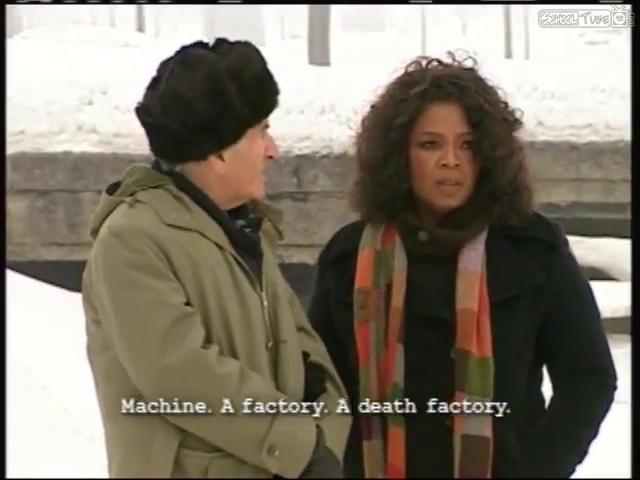
Elie and Oprah star in a very boring film about … walking around in the snow. Here they are in front of the Auschwitz 1 crematorium, feeling the horror.
By Carolyn Yeager
The Germans have been accused of making soap from jewish corpses in Auschwitz , but it takes a jew to make a soap opera there.
Victim Elie Wiesel and victim enabler Oprah Winfrey made a soap opera at Auschwitz on January 29, 2006, exactly ten years ago. The two superstars, along with Winfrey’s film crew, met in front of the entrance to Birkenau and much of that filming was added to the documentary created later in-studio by Oprah’s production team. The resulting 45-minute “movie” was broadcast as part of The Oprah Winfrey Show in May of that year.
Recall it was thirteen days earlier on Jan. 16 that Winfrey announced the “new 2006 translation” of Elie Wiesel’s Night as her newest book club selection. The next day, Jan. 17, Amazon announced it was changing the category of Night from novel to memoir. A lot of questions were raised (as it was known they would be), and the Elie-Oprah Auschwitz trip was intended to distract attention away from those embarrassing questions … to reinforce to the public that Wiesel was a genuine, suffering “death camp”survivor and Night was unquestionably his true story.
It was, in my opinion, a business venture that the advisers to both parties worked out as part of the entire deal between Oprah and Elie. All that the two headliners had to do was show up and act out the roles they knew so well. Oprah has referred to Wiesel as “my world hero” and said she was never the same after reading Night; she was the perfect gullible, unquestioning foil for him.
It was assumed by Oprah and the manipulated public that Wiesel would be her guide to a place he knew well. (And it would have been a perfect time for him to show his tattoo to the camera … if he had one.) But as I will point out, Elie’s words, or lack of them, expose him as a stranger to that place. He tells fiction after fiction, taken from lurid survivor testimonies that were discredited long ago. The only things he really describes are his emotions, his feelings, his thoughts … which become boring and are not convincing either.
In the film @3:43, Elie says, “Each time I come, I – I try not to speak for a day or two or three … ” but from what I can discover, this was only the 3rd time Wiesel had been there. The first was on Janurary 27, 1995, when he spoke at the 50th anniversary of the so-called liberation of the Auschwitz-Birkenau camp. It was probably on this same trip that he filmed a documentary beginning in summer 1994, both in Sighet, Romania and in Auschwitz-Birkenau in Poland. In that film, “Elie Wiesel Goes Home,” he is shown silently walking around the Birkenau grounds with his shirtsleeves rolled up, revealing bare arms with no sign of the tattoo A7713 he says he still has. (He said this as late as 2010.)
This 3rd and last time he made the film with Oprah, which was titled “Auschwitz Death Camp“. The lies and just plain ignorance that are packed into this program is amazing. I will refute some of it here. Elie actually says very little in the beginning but reads passages from Night in order to not speak such stupidities on camera. It is understood by most reasonably sophisticated people that Night is a creative effort—not to be taken literally. Notice that in the film he doesn’t describe his life in the camp with any detail–no names, specific persons, places, events—only generalizations anyone could come up with. For instance, standing in front of Block 17 in Auschwitz 1, where he says he lived, he claims he thinks often about those who died there, but doesn’t offer a single name or how they died.
Oprah takes in every word from the “Professor” (as she calls him) as profound, and though she responds in her trademark super-sympathetic manner, it does seem that she would have liked something more solid from him. She seemed to me to find her hero’s wandering, empty thoughts unsettling – and was pretty much left speechless. This has to be why her production team added so many background film clips and photos portraying the usual media version of the holocaust story—to add some content to a boring walk in the snow with an old con man. Sorry, but if you pay close attention, you should come to the same conclusion.
The main errors refuted
I link to the pages on Oprah.com that I am commenting on, and highlight the offending passages in boldface, so that you can follow and compare.
http://www.oprah.com/world/Inside-Auschwitz/1
As young Elie Wiesel stepped off the cattle car at the Auschwitz subcamp Birkenau, also known as Auschwitz II, he smelled the stench of burning human flesh and saw the crematorium throwing its flames into the sky. “[Mrs. Schächter] wasn’t so mad at all,” Oprah says. “She was a prophet.”
Oprah shows exceptional ignorance by believing that flames could be coming out of a crematorium chimney, but this is what was written in Night. She even believes in Mrs. Schacter, who is simply a character Wiesel invented.1
There was no stench of burning flesh in the air at Birkenau, in spite of quite a number of “survivor novels” that say so. Operating crematoria do not release any smell. Wiesel picked up that idea of “stench” from the testimonies at the Nuremberg tribunal and Soviet reports. In 1955 he thought it was safe to say such things. Today we know what he wrote did not happen.
http://www.oprah.com/world/Inside-Auschwitz/2
The systematic process of determining who would live and who would die was known as “selection.” SS officers briefly sized up each new arrival. Those deemed capable of hard labor, like 15-year-old Elie Wiesel and his father, went into the work camp. All others were sent immediately and unknowingly down the path to Auschwitz’s four gas chambers.
The “selection” was for work placement, not life or death. Those who could not work (children, elderly and sick) went into the barracks at Birkenau where they were fed and allowed to join in activities. There was actually a lot going on. Mail was delivered in both directions, packages were received, the health clinics and hospitals were busy. Some did light work in the camp. Even babies were born.
No one went to a gas chamber because there were none. Wiesel never, ever spoke of a gas chamber in his book Night, written in 1954, and further edited from 1956-58. He only spoke of people taken to the crematorium after they died, which to him at that time was only from disease, hard work and mistreatment—not gas chambers!
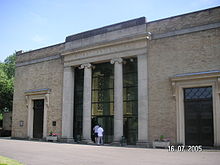
West London Crematorium, 2005
Those selected to die were told they were getting showers, then packed into the chambers by the thousands. Canisters of the deadly chemical Zyklon B were dropped in. As the toxic pellets mixed with air, cyanide gas was released. Death took about 15 minutes to come and felt like suffocation. Proud of their efficiency, SS officers witnessed the gassing as it happened through special peepholes.
None of this is true. Shower facilities were real showers, an important part of the camp disease prevention program.
“Canisters of Zyklon B were dropped in”? What would canisters do? Does Oprah expect that the ‘victims’ opened the canisters themselves?
Death from Zyklon B poisoning would not feel like suffocation. Death by poison gas is painless; one just drifts into unconsciousness.
Claiming that SS officers watched people die through peepholes is the lowest form of defamation of Germans—one thing that Wiesel specializes in. He is pawning off this gruesome “camp gossip” to Oprah and she is not questioning it. But later in the video she did keep saying she “couldn’t understand” how human beings could do such things. The answer is they didn’t.
The grisly task of burning the dead bodies in underground ovens was left to Jewish prisoners. Forced into this horrific job, they temporarily evaded their own death.
What is meant by “underground ovens”? There was no such thing. There were above-ground crematoria for hygienic disposal of human corpses, exactly the same as are found all over the world. There is nothing sinister about cremation retorts. Oven is a word meant to mislead people by bringing up images from the fairy tale “Hansel and Gretel!”
It doesn’t say much for jews if they agreed to kill and cremate their own people just to put off their own death for a short time. There is no way to force someone to do this. This is one of the weakest links in the Jewish Holocaust narrative.
http://www.oprah.com/world/Inside-Auschwitz/3
Professor Wiesel takes Oprah inside one of the few barracks still standing at Auschwitz. He says that prisoners were packed two or more to a bunk on straw mattresses. Professor Wiesel slept on similar bunks at Auschwitz and later at Buchenwald.
Wiesel never wrote of sleeping two (or more) to a bunk. He wrote that at times he was on the top bunk and his father on the bottom. In Buchenwald there was never two to a mattress, especially in the children’s barrack.
Most people don’t find straw mattresses unpleasant to sleep on, especially if they’re tired enough, but most of the people living in Birkenau actually didn’t do much in the way of work and exercise.
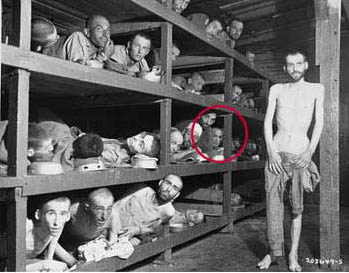
“Elie Wiesel looks out from the far right of the middle bunk.” This photo was staged in an empty barrack because the mattresses have already been removed, 5 days after liberation.
In this photo, taken by soldiers on April 16, 1945, after the liberation of Buchewald, Elie Wiesel looks out from the far right of the middle bunk.
That is not Elie Wiesel in the photo. That person looks nothing like him, but also he writes in his various memoirs that he became seriously ill with food poisoning two days after the April 11th liberation and was taken to a hospital where he stayed for two weeks. Think how ludicrous it is that he should claim to be in both places at the same time! This should tell you something about Wiesel’s irresponsibility when it comes to the holocaust narrative. Anything goes.
Rats, lice and other vermin were rampant. Deadly outbreaks of dysentery, typhus, tuberculosis and malaria wiped out entire sections of this camp. Inmates wore thin cotton uniforms year round, even in the harshest winter. Given only meager rations of stale bread and meatless soup, many starved to death. For prisoners not sentenced to die in the gas chambers, the average life span was barely four months.
Complete nonsense. The barracks at Birkenau were cleaned and disinfected regularly. Wiesel even writes about it in Night.
There are photographs of outdoor workers wearing heavy coats, boots, caps and gloves in winter.
NO ONE STARVED TO DEATH. The emaciated inmates at the end of the war were afflicted with wasting diseases, not starvation.
That the life span was 4 months is an invention picked up by Elie Wiesel from other “survivor stories.” Why then are there millions who were in the camps for several years and are now still getting a reparation check every month?
For saying these kinds of irresponsible things, Wiesel should be reprimanded by the Auschwitz-Birkenau Memorial staff, but he isn’t.
http://www.oprah.com/world/Inside-Auschwitz/7
At Auschwitz 1, the notorious Dr. Josef Mengele, known as the Angel of Death, conducted sadistic medical experiments on prisoners, infecting them with diseases, rubbing chemicals into their skin and performing crude sterilization experiments in his quest to eliminate the Jewish race by any means possible.
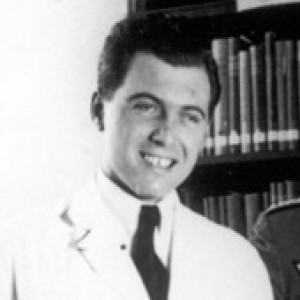
Dr. Mengele was a normal man who served humanity as a doctor.
All the stories about Mengele are inventions. True, he was interested in gaining knowledge about certain medical conditions but not in the way the crazy, narcissistic jews talk about it. He was actually a goodhearted man who has been made into a devil. Elie Wiesel never laid eyes on him anyway.
In Block 11, the secret German police, the Gestapo, interrogated and tortured political prisoners and anyone who dared to disobey.
The Gestapo had an office at Auschwitz. There was a good deal of sabotage and contact with the enemy carried out by Auschwitz 1, 2 and 3 inmates, especially the Poles who had a strong network with Warsaw and London. This could not be allowed and was punished severely. But the Gestapo didn’t regularly “torture political prisoners” or those who “dared to disobey.” That is more camp gossip. Good police know how to gather evidence and get confessions without torturing people. Block 11 was simply the camp jail and it has has been built up into a torture chamber, which it wasn’t.
“At least they had individual deaths—even this becomes a privilege,” Professor Wiesel says. “Here, actually, death was a release because it followed the torture.”
What’s he talking about? Nothing, it’s Wiesel-speak. We can’t know what he means by “torture” since everything is a torture for him. But he pushes the theme that death was preferable to life in the camps—at the same time he describes how he and everyone else clung to life. He preaches that the camps were places of continual punishment, which isn’t the reality at all. If it were, how would so many millions have come out at the end of the war in good health?
http://www.oprah.com/world/Inside-Auschwitz/8
A case filled with empty Zyklon B cans is a haunting reminder of the poisonous gas used by the Nazis for killing prisoners on a massive scale. “When the gas chambers were full, an SS man put on the gas mask, went to the roof, opened the little window there and threw such a can into the gas chamber,” Professor Wiesel explains. “Unspeakable pain and horror—that’s how they were killed. Mothers and children hugging.
Once again, the claim of mass killing is false. Prisoners were kept as healthy as possible in order to be able to work. And also once again, they’re throwing cans into the “gas chamber” through a little window in the roof. Pretty stupid of the SS men!
Also – once again – death by Zykon gas is painless.
“Mothers and children hugging” is pure soap opera fiction to effect the emotions of school kids and women like Oprah. It has been shown conclusively that there never were any homicidal gas chambers. It was black ops propaganda and is now just a plain old Big Lie.
http://www.oprah.com/world/Inside-Auschwitz/10
Baby clothes and shoes are all that remain of the death camp’s smallest victims. Infants were killed immediately on arrival, as were the young mothers who refused to leave their children.
No evidence for that at all. A few items of baby clothes is sure not evidence. The evidence shows that children were provided with kindergartens at Birkenau with painted murals on the wall. Babies were born at the hospital at Auschwitz. I could go on and on.
Wiesel is on overdrive to make Nazis guilty of unspeakable crimes … the better to extort billions from Germany for Israel.
In a short promo video, Oprah says to Elie “You saw the babies thrown into the fire” while an image of cremation “ovens” is shown on the screen. This is purposely misleading because Elie was speaking of babies thrown into open pit fires—but no one will believe that anymore. Wiesel won’t give up his “jewish-babies-burned-alive-in-fire” narrative because fire is part of the Jewish redemption narrative and it is the most evil curse he can put on the hated “Nazis.”
http://www.oprah.com/world/Inside-Auschwitz/12
The Nazis went to sinister lengths to profit from the extermination of millions, and no possible resource was wasted. Human hair shorn from victims’ scalps was gathered and sold to German factories to make cloth.
Human hair was cut short to control body lice that the jews and others brought with them to the camp–not to make a profit. They no doubt couldn’t have profited, considering all the barbers that were necessary. It was a life-saving measure.
What was done with the hair after it was cut was of no importance to the inmates. Do you want to keep the hair that is cut from your head? Do you worry that the salon or barber shop will make a profit from it? I doubt it. Wiesel tries to connect cutting of hair with extermination, but there is no connection. Failing that, he projects it as a humiliation.
Wiesel wants you to believe that the “Nazis” made money off the jews’ bodies by selling their hair, when in fact they were just making use of all resources in their wartime economy. Is it better to throw stuff away, or to recycle it?
Final thoughts
We could ask why Elie didn’t take Oprah to see the swimming pool. Or take her into one of the large kitchens, or the theatre. Or point out where the soccer field had been in Birkenau. Apart from the fact that he may not even know about this places, since he never lived there, both knew that bringing up that aspect of the camps would defeat the purpose and soapiness of their soap opera. Their purpose was to reinforce the stature of Elie Wiesel and his book Night, and a secondary benefit was to give Oprah more tear-jerking content for her TV show. In May 2011 Night was #3 on the Top Ten bestseller list from the Oprah Book Clubs in their final 10 years, according to Nielsen BookScan.
Winfrey did her best as an actress even though she broke character in a couple places, halting expressing her confusion about the story, saying she couldn’t make any sense of it. Wiesel immediately counseled her that she should not look for sense because none could be made of it. It is unexplainable and inexplicable … and a permanent mystery. As for upholding his part in making the film interesting, Wiesel totally failed. He was a bore. His Auschwitz experience remains preposterous and unconvincing—really just a soap opera.
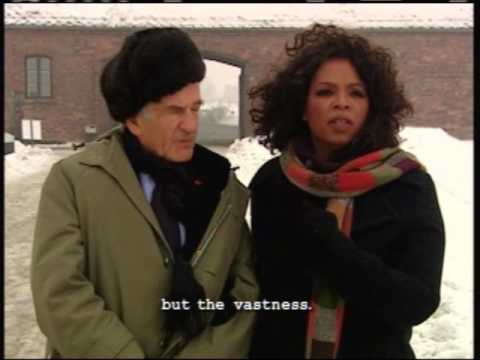
Endnotes:
- Wiesel said in an interview with the Paris Review in 1984:
Sighet, my little town, all the characters that I am inventing or reinventing, all the tunes that I have heard. It is always, whatever its name, that little town Sighet.
The real Sighet was actually the largest city in Maramures province with a population of 50,000 to 90,000 people, and was 35 to 50% Jewish … as written by Wiesel himself in Un di velt hot geshvign, the Yiddish precursor to Night. But in Wiesel’s other books, Sighet is a product of his imagination.
3 Comments
Category Featured | Tags: Tags: Auschwitz-Birkenau, crematoria, Jewish Soap, Night, Oprah Winfrey, Soap opera, Zyklon B,
Social Networks: Facebook, Twitter, Google Bookmarks, del.icio.us, StumbleUpon, Digg, Reddit, Posterous.
Sunday, February 2nd, 2014
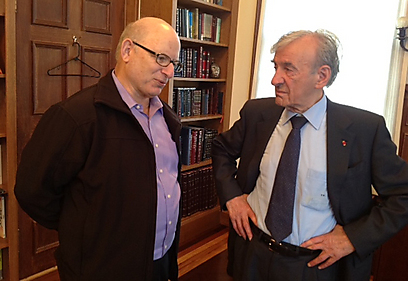
Elie Wiesel, right, in his office at Boston University with his Israeli editor, Yoel Rappel, whose interview with the famous survivor was published on January 28th in Israel’s Y-Net News.
By Carolyn Yeager
“Personal reasons” has been given for Elie Wiesel’s failure to attend this year’s annual International Day of Commemoration in Memory of Victims of the Holocaust at Auschwitz-Birkenau January 27th. This United Nations-declared commemoration day (since 2006) is being incorrectly called “Holocaust Memorial Day” or “Holocaust Remembrance Day” by the media and others who don’t feel like repeating the long, actual title.
The latter can become a problem because, as Wiesel’s interviewer pointed out in what follows : “The American nation officially commemorates the memory of the victims of the Holocaust on the same day as the State of Israel” — that is, on Yom Hashoah according to the Hebrew calendar, which falls in the Spring (April or May). This event is called “Days of Remembrance” and lasts for 7 days, beginning on Saturday evening Shabbat and ending at Shabbat one week later. In this, like in so much else, the U.S. is in lock-step with Israel (with Israel leading, the United States Congress following).
However, both the U.S. and Israel also support and join in with the newer January 27th United Nations-proclaimed commemoration, since it was conceived and pushed through the UN by the State of Israel. See here at bottom of page. That gives the world two major “Holocaust remembrance” events, all the better to “engrave” the holocaust into the minds of all humanity, but especially Western man.
The Interviewer
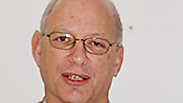 Yoel Rappel grew up in Israel and lived most of his life there. We’re not told if he was born there, but it seems so. He worked 40 years as a journalist and senior program editor at the Israel Broadcasting Authority, Israel’s main radio channel. Before coming to Boston University as Visiting Scholar at the Elie Wiesel Center for Jewish Studies, he also taught at Bet Berl College, the Avshalom Institute for Israel Studies, and served as content manager at the Center for Jewish Identity in Bar Ilan University … all in Israel.
Yoel Rappel grew up in Israel and lived most of his life there. We’re not told if he was born there, but it seems so. He worked 40 years as a journalist and senior program editor at the Israel Broadcasting Authority, Israel’s main radio channel. Before coming to Boston University as Visiting Scholar at the Elie Wiesel Center for Jewish Studies, he also taught at Bet Berl College, the Avshalom Institute for Israel Studies, and served as content manager at the Center for Jewish Identity in Bar Ilan University … all in Israel.
He serves as project manager for the Elie Wiesel Archive. He is the editor of the Hebrew editions of Prof. Wiesel’s books “The Biblical Soul,” “The Hasidic Soul” and “The Talmudic Soul,” which were published in Hebrew by the Yedioth Books publishing house. [Getting everything ready for Elie Wiesel’s coming sainthood -cy]
The Interview
[Rappel points out that it was Wiesel who coined the expression, “Not all victims were Jews, but all Jews were victims.” ]
Wiesel: “The Holocaust is a unique event, but it has a universal significance which must be memorized incessantly.”
[The reason for this, Rappel tells us, is so it will be engraved in people’s minds, so that the events of 1939-1945 will not repeat themselves and the world will not be indifferent and silent*, as it was then.] *A reference to the Yiddish book, “And the World Remained Silent” claimed to have been written by Wiesel.
Wiesel: “Unfortunately, anti-Semitism still exists. It has been alive for more than 2,000 years, and will likely continue living. I thought that the memory of the Holocaust would shame those boasting anti-Semitic opinions. I was wrong. It still exists in different countries, and it seems people are no longer ashamed to be anti-Semitic.”
[Rappel says “the murky wave of anti-Semitism sweeping over the Western world, as well as Eastern Europe (with the recent incidents in Hungary and Ukraine), is fresh.]
Wiesel: “The modern anti-Semite is, first and foremost, anti-Israel. It’s very difficult to separate between the two. There are anti-Semites who are only anti-Israel. Once I thought that anti-Semitism had ended; today it is clear to me that it will probably never end. It might weaken sometimes, but it will continue existing, because in different countries there is no shame in being an anti-Semite. We must remember that anti-Semitism led to Auschwitz. Without anti-Semitism there would have been no Auschwitz.”
[Rappel says that Wiesel is one of the State of Israel’s greatest advocates, and that Wiesel argues that the fundamental problem {today?} is the attitude towards Israel and not anti-Semitism.]
Wiesel: “It’s clear to me that one can’t be Jewish without Israel*. Religious or non-religious, Zionist or non-Zionist, Ashkenazi or Sephardic – all these will not exist without Israel. The State’s existence is the oxygen of the image and ideas of the new anti-Semitism.” *Dangerous, fanatical talk. It follows that if Israel goes, so also do Jews. With that thinking, anything is allowed to Jews to prevent it … is what Wiesel is getting at. The failure of Israel would be another form of “extermination of the Jews,” another “holocaust.” -cy
[Wiesel is asked whether the public dispute over circumcision and ritual animal slaughter also stem from anti-Semitism.]
Wiesel: “In my opinion, it stems first of all from ignorance and disregard of the Jewish faith. Those who raise such ideas and others will soon come up with the idea to cancel Shabbat, so that Jews will rest on Sunday. It’s more of a case of ignorance, and it leads to harassment against the foundations of Judaism.”
[Rappel wants to know if the different phenomena experienced recently by the Jewish community in the United States can be defined as anti-Semitism.]
Wiesel: “There are expressions of anti-Semitism, yet we can’t talk about an anti-Semitic movement but about groups of anti-Semites which operate in different places, and we don’t know how many members they have. This reality must also concern us, because it could expand.”
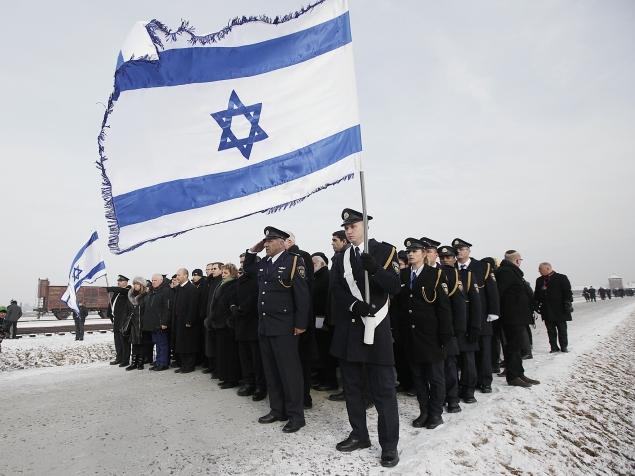
What Wiesel Missed – Members of Israeli parliament, the Knesset, ceremoniously and ostentatiously mark the 69th anniversary of the liberation of Auschwitz in Oswiecim, Poland on Jan. 27, 2014. The delegation spokesman made it a point to say that the difference between then and now is that they now have a state and a military force of their own with which to protect themselves.
2 Comments
Category Featured | Tags: Tags: anti-Semite, anti-Semitism, Auschwitz-Birkenau, Boston University, Holocaust remembrance, Israel, Joel Rappel, shabbat, Yom Hashoah,
Social Networks: Facebook, Twitter, Google Bookmarks, del.icio.us, StumbleUpon, Digg, Reddit, Posterous.
Wednesday, March 7th, 2012
By Carolyn Yeager
copyright 2012 Carolyn Yeager
Elie Wiesel questioned under oath in a California courtroom in 2008:
Q. And is this book Night that you wrote a true account of your experience during World War II?
A. It is a true account. Every word in it is true.
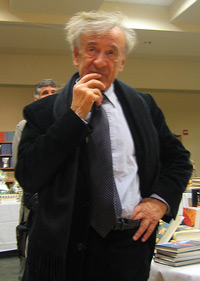
Elie Wiesel manning his table at a Jewish book fair in Austin, TX, 2006. The new translation of Night by his wife Marion had come out in January of that year, and it was immediately chosen for Oprah Winfrey’s book club.
In Part One, I established that the decision to rebrand Night into an autobiography was the reason for a new translation, in which necessary changes could be made to better ‘fit’ the story both to the real Elie Wiesel and the known facts of the Hungarian deportation.
When the 2006 translation came out, with its new classification to “autobiography,” questions arose from some circles. Responding to these questions, Edward Wyatt wrote an article in the NewYork Times on Jan. 19, 2006, in which he quoted Jeff Seroy, senior vice president at Farrar, Straus & Giroux, parent company of Night publisher Hill & Wang, as strongly denying that changes were made to bring the book more in line with the facts. “Nonsense,” said Seroy. “Some minor mistakes crept into the original translation that were expunged in the new translation. But the book stands as a record of fact.”
Blaming the Translator
“Mistakes in the original translation” can only mean mistakes by Stella Rodway, the original translator! But we have already shown that Stella Rodway faithfully reproduced the French La Nuit, which was Wiesel’s own work. The author and publisher are casting these changes as translation errors to divert attention away from Elie Wiesel’s own errors—part of their campaign to pass Night off from now on as “a record of fact.”
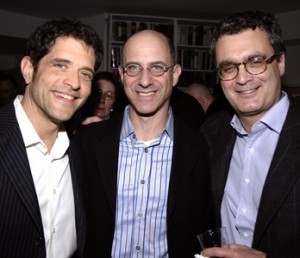
Publisher Jeff Seroy, center, with writer Brad Gooch to his left, Doug Stumps on his right .
A record of fact it isn’t
When I ended Part One, Eliezer and Father were still in the train car on their way to Buchenwald. You will recall that the Yiddish, the French and thus the original English version of Night specified the trip took 10 days and 10 nights from Gleiwitz (on the former German/Polish border) to Buchenwald. Since we know from standard historical sources1 that the prisoners were evacuated from Monowitz on Jan. 18 and arrived in Gleiwitz the next day, Jan. 19; and since according to the description in Night itself, they spend three days in Gleiwitz (Jan. 20-22), this would make their day of arrival February 1, 1945. But in Night, Father’s death takes place the night of Jan. 28-29, three days before they arrived! This is why Marion Wiesel removed the number 10 in her new translation, leaving the number of days and nights undetermined.
A strange detail that actually belongs in Part One is on page 87 of the original Night. Eliezer remarks, after his and his Father’s deliberations and final decision to go on the march: “I learned after the war the fate of those who had stayed behind in the hospital. They were quite simply liberated by the Russians two days after the evacuation.” The evacuation, as we all know, was on the 18th. We also know the Russians did not arrive on the 20th of January! The actual liberation day is January 27. What possessed Wiesel to write this? Well, because it was in Un di velt: “Two days after we had left Buna, the Red Army occupied the camp. All the sick had stayed alive.”
From the point in the story of Eliezer and Father’s arrival at Buchenwald there are no significant changes made by Marion Wiesel to the original French and English versions. But there is much in all the versions that differs strikingly from the “official holocaust history” as written by acknowledged official chroniclers such as Danuta Czech. So I will continue with comparisons between Night and “official history,” along with some very significant changes made from Un di velt hot geshvign to Wiesel’s edited French La Nuit.
Arrival at Buchenwald: 26 Jan. or 1 Feb.?
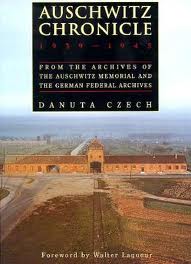 Danuta Czech, in her Auschwitz Chronicle1, records that on January 26,
Danuta Czech, in her Auschwitz Chronicle1, records that on January 26,
A transport with 3,987 prisoners from Auschwitz auxiliary camps reaches Buchenwald. There are 52 dead prisoners in the transport. 115 prisoners die on the day of arrival. Their corpses are delivered to the autopsy room. (P 801)
This is the transport that carried Lazar and Abraham Wiesel/Viezel, Miklos (Nikolaus) Grüner and all of the inmates of Monowitz whose names are on the transport list.2 According to Czech, the Monowitz prisoners began their march on the evening of January 18, 1945, with “divisions of nurses placed between the columns” of 1000 each (P 786), arriving at Gleiwitz Camp the following evening. On Jan. 21 “they are loaded in open freight cars with other prisoners from Auschwitz who have arrived in Gleiwitz.” (P 788) From Jan. 21 to Jan. 26 is five days of travel … not ten, as Wiesel wrote in Night.
The narrative in Night gives us a date of Jan. 22 for the boarding of the train, one day later than Czech. And while Night gives the number of days on the train (10), it does not name the date of arrival.
Hilda Wiesel says her father died on arrival
Totally contradicting what is written in Night, Hilda Wiesel Kudler, Elie’s oldest sister, in her testimony for the Shoah Foundation in 1995, said she learned from her brother that their father died as he stepped off the train.
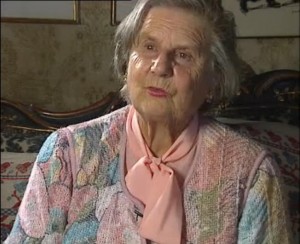
Hilda Wiesel Kudler, in France, giving her videotaped testimony to the Shoah Foundation
And I said, where is father? And he replied, he’s gone back to Sighet; he[Elie] didn’t want to tell me [that he was dead]. And I repeated, but where is he? And he insisted he was at Sighet. And I said, look, I want you to tell me the truth. Because he knew the date of my father’s death. You know, they did a long march3 from Auschwitz, then they put them on the train to go to Buchenwald; he died gasping for air; when he stepped off the train, he died gasping for air; at Buchenwald. But he[Elie] knew the date.
From this, we can better understand something about Elie Wiesel—that he has never had a problem with making up stories that “sound better” than the truth. But, if Hilda is correct in her recall, and if their father really was one of the 115 inmates who Danuta Czech reports died on the day of arrival, then Wiesel’s long, melodramatic story of watching his father sicken and die over a ten-day period in Night is fiction. All of it—including his father being whacked on the head by a cruel “officer” in the barracks.
The day of arrival for this transport is Jan. 26, but according to the timeline in Night, it arrives on Feb. 1. Either way, it doesn’t correspond to the date of Jan. 28 that Wiesel, for reasons unknown, selected as the date his fictional Father died.
You might also be interested to know that Hilda is named Deborah in Un di velt; the name Hilda is never used. It was Wiesel who changed it to Hilda in La Nuit.
Un di Velt says Father dies a week after arrival in Buchenwald, Night says 8-10 days … yet it is January 28 … or is it the 18th Day of Shevat?
Regular readers of this blog will know this already, but it bears repeating yet again: there is no Shlomo Wiesel in the official history or in the records who fits the profile of “Father” as described by Elie Wiesel in Night. There is an Abraham (sometimes shortened to Abram) Viezel who is recorded in several places—on a medical report at Auschwitz, on the transport to Buchenwald, and on a death certificate dated Feb. 2, 1945, seven (7) days after arrival. This Abraham was born Oct. 10, 1900, making him 44 years old when he died. Recall that Night gives Father’s age as 50 in 1944 (SR, P 40).
Wiesel’s description has the transport to Buchenwald arriving on Feb.1st. But that’s just the beginning. After arriving, this is the timeline given in both the original Night and Marion Wiesel’s 2006 translation:
It was daytime when I awoke. I went to look for my father. (Feb. 2nd)
[…]
On the third day after our arrival at Buchenwald, everyone had to go to the showers [his father went too-cy]. Even the sick who had to go through last. (Feb 4th) […] Struck down by dysentery, my father lay in his bunk, five other invalids with him. I sat by his side watching him … A week went by like this. (Feb. 11th or Feb. 8th depending on how you read it)
[ . . . ]
When I got down after roll call, I could see his lips trembling as he murmured something. […] Then I had to go to bed. I climbed into my bunk, above my father, who was still alive. It was January 28, 1945. (still Feb. 8 or 11) I awoke on January 29 at dawn. In my father’s place lay another invalid. They must have taken him away before dawn and carried him to the crematory.” (Feb 12th or 9th) [Stella Rodway translation, pp 107-112]
The timeline in Un di velt is not in doubt:
On the seventh or eighth day of our being in Buchenwald, the bunk-elder [should be block-elder -cy) who used to deal out bread for the whole bunk [sic], came to me. . . .
[ . . . ]
On the same day, in the evening, disaster struck. The end. During roll call. The healthy had to go out of the block in order to be counted by the S.S. men. The sick stayed in their bunks. My father and I thus stayed inside. He — because of his dysentery and I — because of my bandaged foot. Father was lying in the lowest bunk and I — in the uppermost.
[ . . . ]
After roll call, I immediately jumped down from the uppermost bunk and ran to him. He was still breathing. But — he was silent.
[ . . . ]
For a couple of hours I stayed by him and looked at his face long and well […] Then they forced me to go lie down to sleep. I climbed up to the uppermost bunk and I did not know that in the morning, on awakening, I would find my father no more.
It was the eighteenth of Shevat, 5705.
* * *
Nineteenth of Shevat. Early in the morning.
I got up and ran to my father. Another sick man was lying in his place.
I had a father no more. (pp 233-238)
Readers might be surprised to learn that the Hebrew calendar date of 18-19 Shevat, 5705 corresponds to February 1-2, 1945! How neat is that? So, in Un di velt Father dies seven days after arrival, on the very same day as Abraham Viezel died, who was officially recorded at Buchenwald with the registration number of 123488 and the Auschwitz registration number of A-7712. (However, Un di velt also says that the trip from Gleiwitz to Buchenwald took ten days, which means they could not have arrived until sometime in February. Seven days from that time would not be Feb. 2nd.)
So can we conclude from this that Abraham is Shlomo? Not necessarily. The Yiddish author reports Father’s death as occurring during the night of 18-19 Shevat (Feb. 1-2), but Elie Wiesel, author of La Nuit, says the date is Jan. 28th! Why? Who can answer that but Elie Wiesel? He certainly knows what the month of Shevat and the year 5705 means … or he could have easily found out.
Or can we conclude that Un di velt was written by Lazar Wiesel, as Nikolaus Grüner claims … that he wrote his story as a father-son relationship … and that he was perhaps not the brother of Abraham as Grüner says he was? (It’s noted on Lazar’s Buchenwald file card that his father was also in Buchenwald; his mother in Auschwitz.) Well, again, not necessarily. There are other possibilities. But I’m getting ahead of myself.
The facts are, there are problems with all of these theories; none is a perfect fit. We can ask: If Elie Wiesel is the author of Un di velt hot geshvign, why did he change so many of the underpinning facts of the story when he rewrote it in French as La Nuit? This is a real head-scratcher. We can also ask: Why did Naomi Seidman, the Jewish professor who discussed in detail some of the differences between the Yiddish book and Night, not mention the 18th of Shevat? Is it because she couldn’t find an explanation for it? Siedman, Ruth Franklin and other Jewish reviewers have never brought up some of these Yiddish to French discrepancies. They are too embarrassing a problem for them.
What we can safely say is that no matter who the author of Un di velt was … he was totally unfamiliar with the real facts of when the Monowitz prisoners arrived at Buchenwald. Was it because he was not one of them? Was it because he was not concerned about accuracy since his story was directed at a non-critical audience—a Yiddish-speaking Jewish audience? As we continue, we’ll find more mystifications, but also a few certainties.
What happens to Eliezer after Father’s death?
Wiesel writes in Night (essentially the same in all translations):
I had to stay at Buchenwald until April eleventh. I have nothing to say of my life during this period. […] I was transferred to the children’s block, where there were six hundred of us. […] I spent my days in a state of total idleness. And I had one desire—to eat. I no longer thought of my father or of my mother. (SR, P 114)
He continues that on April 10, a general evacuation of the remainder of the camp—20,000 prisoners in all, including “several hundred children”—was begun but was soon interrupted. It resumed on the 11th but was again interrupted around ten a.m. when the camp inmate “resistance movement” rose up, firing guns. And then at 6 p.m. on that same day the first American tank arrived. This corresponds pretty well with the official story, but then it goes astray.
In a November 2000 interview with Oprah Winfrey, Wiesel recalled:

Elie interviewed by Oprah in 2000.
… and we [children] were left until the end. But every day we marched to the gate anyway. I was near the gate more than five times before I was released, and each time, the gate closed just before I came to it.
Ah, we have heard this before, haven’t we? As exaggerated as it sounds, in Un di velt the author goes even further. He writes:
I didn’t even bother to try hiding myself. Let myself be born along with the stream. Tens of times I stood before the iron camp gate, on the threshold of death, and always something happened which brought us back to the block.
Un di velt continues: “If I was not killed then it is merely thanks to almightly chance. For – because of the hunger, I even wanted to go to the gate: outside the gate, they were distributing bread and marmalade.”
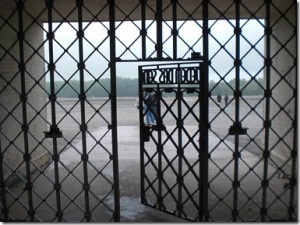
The front gate at Buchenwald, from the inside looking out, that Wiesel says he marched right up to “tens of times” but was always turned back!
- Liberation brings Freedom and Revenge
UdV, P 244: The first gesture of freedom: the starved men made an effort to get something to eat. They only thought about food. Not about revenge. Not about their parents. Only about bread. And even when they had satisfied their hunger—they still did not think about revenge.
SR, P 115: Our first act as free men was to throw ourselves onto the provisions. We thought only of that. Not of revenge, not of our families. Nothing but bread.
Oprah Winfrey interview: Oprah asks, “After you were liberated, what did you do?” Wiesel answers: “The first thing many of us did was reassemble to say a prayer for the dead.” (page 5)
* * * *
UdV, P 244: Early the next day Jewish boys ran off to Weimar to steal clothing and potatoes. And to rape German girls [un tsu fargvaldikn daytshe shikses]. The historical commandment of revenge was not fulfilled.
LN, P 178: Le lendemain, quelques jeunes gens coururent à Weimar ramasser des pommes de terre et des habits—et coucher avec des filles. Mais de vengeance, pas trace.
SR, P 116: On the following day, some of the young men went to Weimar to get some potatoes and clothes—and to sleep with girls. But of revenge, not a sign.
MW, P115: The next day a few of the young men ran into Weimar to bring back some potatoes and clothes—and to sleep with girls. But still no trace of revenge.
In this case, Wiesel made the change from ‘rape’ to ‘sleep with’ in La Nuit. The expression for “German girls” that we find in the Yiddish book was also removed. The term that was actually used is shikses, a word which originally meant “abomination” and which is used today as a term of contempt for all non-Jewish women. In other words, in saying daytshe shikses, the author was expressing, in rather vulgar terms, his contempt and hatred for German women. This apparently was not good for the eyes of the Goyim to see. It was changed by Wiesel in the French La Nuit, and thus it never reached our eyes until now.
Yet, the Yiddish author goes even further and decries the failure of the Jewish males to take a proper revenge, which is here envisioned as a much larger public act of retribution than the “too mild” raping of German women. (Public retribution, of course, did come later with the Nuremberg Military Tribunals.)
Eliezer is hospitalized for two weeks—April 14 to April 28
UdV P 244: Three days after liberation I became very ill; food-poisoning. They took me to the hospital and the doctors said that I was gone. For two weeks I lay in the hospital between life and death. My situation grew worse from day to day.
SR P 116: Three days after the liberation I became very ill with food poisoning. I was transferred to the hospital and spent two weeks between life and death.
MW P 115: Three days after the liberation of Buchenwald, I became very ill: some form of poisoning. I was transferred to a hospital and spent two weeks between life and death.
Three days after liberation on April 11th is April 14th. Thus, Eliezer is in the hospital from April 14 until April 28—extremely ill, close to death. In his 1995 memoir, All Rivers Run to the Sea, Elie Wiesel claims that on that day (the 14th) he was thrown a can of lard, which he apparently ate although he doesn’t remember doing so. He lost consciousness and awoke in a hospital. But the addition of this story, which is in the original Un di velt, presents serious problems for Elie Wiesel. Perhaps the hospital story had slipped his mind when he decided to claim he was one of the survivors lying on a bunk in the “famous Buchenwald liberation photograph.” Because he was in the hospital …
He cannot be in the famous Buchenwald liberation photo taken on April 16 …
I have already demolished the false claim that Wiesel is in that photograph here. But on top of that, our translator found an interview of Leo Eitinger, a Jewish Czech-born psychiatrist, by Harry James Cargas, a friend and biographer of Elie Wiesel, which contained this gem:
HJC: The same thing happened with Livia Rothkirchen at Yad Vashem as happened with you. I was there doing research on atrocity photography for my book A Christian Response to the Holocaust and saw a photo that covers a large wall, of seventeen men lying in their bunks at liberation time. I think you’ve probably seen this picture. Wiesel and Dr. Rothkirchen passed it by many times, over a several-year period, before he told her he was in that photograph. I asked Elie if I could write something about it and he said, “No.” I wrote something and showed it to him and he gave me permission to publish it.
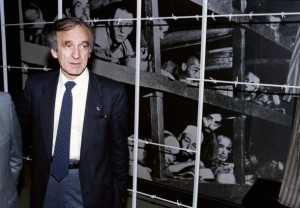
The photo at Yad Vashem in Israel with Elie Wiesel posing in front of it in 1986 after receiving the Nobel Peace Prize in Oslo.
LE: I didn’t know Elie is in the photo.4
Cargas’ book was published in 1993, ten years after it was publicly announced that Elie Wiesel was in that photograph. Apart from the revelation that Cargas has to ask permission from Wiesel before he publishes anything about him, can you imagine that after walking by that famous photo for several years, Wiesel would finally think to say, “Oh hey, that’s me laying there, back in the shadows.”
He cannot have been present to agree to and sign the Military Questionaire on April 22 …
Much has been made by holocaust historians like Kenneth Waltzer and others I won’t name that this Fragebogen made out for Lázár Wiesel proves that Elie Wiesel was in Buchenwald. The birth date is not Elie’s; the date of arrest is not Elie’s; the signature is not Elie’s; the registration number belongs to another prisoner (Pavel Kun) who died only a month earlier; and on top of all that … Elie himself tells us in Night that he was lingering between life and death in the hospital on April 22. He was still six days away from having recovered enough to leave the hospital.
He cannot be in the photograph of the “Boys of Buchenwald” taken on April 27.
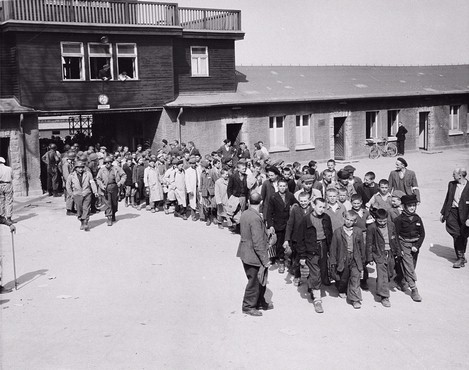 Kenneth Waltzer also claims on his Michigan State University website that Elie Wiesel is “seen to the left” (short boy fourth from the front in left row wearing dark suit in front of the taller boy wearing a beret) in this photograph of the youths being transferred from the barracks inside Buchenwald to the former SS barracks on the outside. Why is Waltzer not paying attention to what is written in Night — that Eliezer was put in the hospital on the 14th of April, at death’s door, and remained for two weeks? One really has to wonder at the stupidity of holocaust historians. Or more likely — how stupid they think the rest of us are! See The Many Faces of Elie Wiesel.
Kenneth Waltzer also claims on his Michigan State University website that Elie Wiesel is “seen to the left” (short boy fourth from the front in left row wearing dark suit in front of the taller boy wearing a beret) in this photograph of the youths being transferred from the barracks inside Buchenwald to the former SS barracks on the outside. Why is Waltzer not paying attention to what is written in Night — that Eliezer was put in the hospital on the 14th of April, at death’s door, and remained for two weeks? One really has to wonder at the stupidity of holocaust historians. Or more likely — how stupid they think the rest of us are! See The Many Faces of Elie Wiesel.
The book’s ending: What does the long passage in Un di velt hot geshvign tell us?
UdV P 245: One fine day I got up—with the last of my energy—and went over to the mirror that was hanging on the wall. I wanted to see myself. I had not seen myself since the ghetto.
From the mirror a skeleton gazed out.
Skin and bones.
I saw the image of myself after my death. It was at that instant that the will to live was awakened.
Without knowing why, I raised a balled-up fist and smashed the mirror, breaking the image that lived within it.
And then—I fainted.
From that moment on my health began to improve.
I stayed in bed for a few more days, in the course of which I wrote the outline of the book you are holding in your hand, dear reader.
But—
Now, ten years after Buchenwald, I see that the world is forgetting. Germany is a sovereign state, the German army has been reborn. The bestial sadist of Buchenwald, Ilsa Koch, is happily raising her children. War criminals stroll in the streets of Hamburg and Munich. The past has been erased. Forgotten.
Germans and antisemites persuade the world that the story of the six million Jewish martyrs is a fantasy, and the naive world will probably believe them, if not today, then tomorrow or the next day.
So I thought it would be a good idea to publish a book based on the notes I wrote in Buchenwald.
I am not so naive to believe that this book will change history or shake people’s beliefs. Books no longer have the power they once had. Those who were silent yesterday will also be silent tomorrow. I often ask myself, now, ten years after Buchenwald:
Was it worth breaking that mirror? Was it worth it?
SR P 116: One day I was able to get up, after gathering all my strength. I wanted to see myself in the mirror hanging on the opposite wall. I had not seen myself since the ghetto.
From the depths of the mirror, a corpse gazed back at me.
The look in his eyes, as they stared into mine, has never left me.
MW P 115: One day when I was able to get up, I decided to look at myself in the mirror on the opposite wall. I had not seen myself since the ghetto.
From the depths of the mirror, a corpse was contemplating me.
The look in his eyes as he as he gazed at me has never left me.
The difference in length between the Yiddish and the English passage is the first thing that strikes us. The Yiddish writer had a lot to say in these final thoughts. He regained his “will to live” right there in the hospital. Twice he speaks of writing an outline and notes for Un di velt hot geshvign while still in his hospital bed. But there is no record by Elie Wiesel anywhere that says he did any writing in preparation for writing his “testimony” while in the camp (in fact, just the opposite), or at any time in advance of 1954.
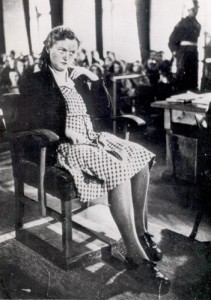
Ilse Koch on the witness stand in 1947. She was seven months pregnant and the only woman brought before the American Military Tribunals held at Dachau.
The tragic true story of Ilse Koch is that she gave birth to one child while a prisoner of the Americans but she certainly was not allowed to raise him. She was hounded, vilified and persecuted after the war, retried by a German court in 1951 after being acquitted at the IMT, and ultimately given a life sentence—solely, it can be argued, to satisfy Jewish vengeance. She committed suicide in prison in 1967.
The Yiddish author also mentions the “six million Jewish martyrs” … in 1954. This number emerged from the Nuremberg Tribunals, but we know that claims of “six million Jewish victims” goes all the way back to the 1890’s.
All this and more was cut out for the French La Nuit (which, remember, was written by Wiesel) and the English versions which were taken from the French. As has been noted by Jewish commentators themselves, the Yiddish writer is an angry, politically-minded religious Jew who expected, or wished, the world to have been transformed by the travail of the Jews during WWII. He is bitterly disappointed. There is more in this final chapter of the Yiddish book that doesn’t appear in the French or English versions. Here is just one passage:
Dreams of truth, of freedom are false dreams for men. Visions of justice and equality are false visions for men. Man is: the struggle for bread, for meat; man is: the struggle to satisfy one’s own instincts.
Man is instinct to the core. Flesh to the core. And not heart. And not spirit. And not morality.
I learned that in Buchenwald. And what one learns in such conditions is without a doubt the truth, the purest truth. For man can really know man only in extreme conditions, when he has thrown away from himself all masks, social and psychological, and appears before us naked, as he is in truth.
In Buchenwald I saw the true face of man. The face of a human animal, which is worse than a true animal. O God, woe is you, woe is man, how trifling and puny. Ought you to even exist, if the son of Adam was made in your image!
God . . . I had ceased to believe in his existence. But despite that, I continued to believe in his evil. (UdV, P 240-41)
Was this written by Elie Wiesel? If it was, he is a man who has put on his own mask to play the game of Jewish vengeance against the goyim persecutors of his people. In other parts of Night, Wiesel writes of losing his faith in a caring God, of no longer following his religion—but later he denied that is true, even though he wrote it! But this passage in Un di velt is too passionate to dismiss as merely a passing sense of discouragement. That is, of course, unless it is just a literary construct and doesn’t reflect any truth of the author.
What does it all mean?
The title of this two-part article is “What Changes were made to Elie Wiesel’s Night, and Why.” I didn’t promise to solve the mystery of the author of Un di velt hot geshvign, but I did hope I might do so, or at least eliminate some contenders.
I confess I expected there to be more difference between the Yiddish and the French books than it turns out to be. It is now clear that La Nuit was taken directly from Un di velt, although that doesn’t mean they were written by the same person. However, that is the greater likelihood unless it can be proven otherwise. Similarly, if Elie Wiesel is the author of Un di velt, it doesn’t mean he was in the camps. The fact that the books are filled with errors argues against it.
Night is a novel
It’s difficult to come to any certainties when the material we have to work with is so internally inconsistent and when there are several versions of it—similar in some ways to the many versions of the Anne Frank Diary. But we can conclude for certain that Night only works as a novel, not as an autobiography—no matter how much the Jewish spin doctors say that a memoir, to be a work of “great literature,” must include some fictional flights of fancy. Nowhere does Night fit the facts. Even with wife Marion’s changes in 2006, it couldn’t be pulled together enough to make a convincing true-life testimony. And we know how many of these “survivor novels” there are around. It’s not like many other hopefuls didn’t have the same idea!
The Lazar-Lázár Riddle
In spite of all the above, I would like to propose a hypothetical scenario, one that I am not endorsing, for obvious reasons, but that does have the value of answering one of the more ignored aspects of this riddle, namely the way the 32-year-old Lazar Wiesel disappeared at the same time the 16-year-old Lázár Wiesel appeared. This cannot be denied. Thirty-one-year-old Lazar arrived at Buchenwald in January; sixteen-year-old Lázár left there in July. The easiest explanation for this is that Lazar wanted to have the papers of a 16-year-old Buchenwald orphan so he could be sent to France. In the confusion of the last months of the war and the immediate post-war period, this kind of thing became more possible. Such an explanation may sound a little far-fetched, but is it any harder to swallow than Elie Wiesel not having the tattoo (Auschwitz ID number) that he says he has? Or Elie Wiesel not having his own Buchenwald identification number, but “borrowing” a dead man’s (Pavel Kun, 2 years older than Elie) right before, or after, liberation? These things don’t make sense. Nor does the fact that in La Nuit Elie Wiesel wrote that his father died on Jan. 28, 1945, while in the Yiddish book that he also claims to have written as his own “testimony” the date is Feb. 2nd? Or that he wrote that the Russian Army took over the Auschwitz complex two days after its evacuation, which everyone knows is false?
Elie Wiesel even wrote in Night that his foot was operated on right before the evacuation of Auschwitz, while in his later real memoir, All Rivers Run to the Sea (pp 89-90), he flat-out recalled it as his knee, something that could not be mis-remembered. I could list many of these senseless “mistakes,” many of which I have written about in earlier articles.
There is something that doesn’t fit well into this Lazar-Lázár hypothesis, though—that is, that we have pictures of the real Elie Wiesel in France at the Jewish welfare orphanage, OSE. But how did he get through a year at Auschwitz and Buchenwald with no records of his being there … and a poor memory of what occurred and when? Did he somehow manage to attach himself to the Buchenwald transport with the stolen identity papers? But also, there are other ways he could have come to be at the Ecouis homes in France than in the children’s transport from Buchenwald. Just as there are other ways he could have come into possession of the Yiddish Un di velt without writing it himself.
Was Elie Wiesel in the camps?
My answer is still no. Wiesel could have been in some camps in some capacity under some auspices, but he is not telling the truth about what camp experience he did have. That means Hilda Wiesel Kudler is also not telling the truth but is standing by her brother. She says at the end of her bitter testimony to the Shoah Foundation, “I will not forget, and I will not forgive.” Have you ever wondered why Elie has not contributed a videotaped testimony to the Spielberg/USC Shoah Foundation library?
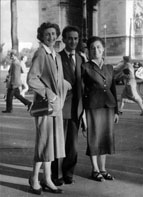
Elie Wiesel with his older sisters Bea (left) and Hilda (right) in Paris after the war, exact date unknown.
Wiesel’s other sister, who changed her name to Beatrice from Batia, never wrote or testified a word about it. She did go to work for Jewish organizations in Germany, however, immediately after the war, helping Jews to emigrate to wherever they wanted to go, including Palestine. The whole family were committed Zionists, as were most Eastern European/Russian Jews who were able to flood into the West because of the war. ‘Bea’ finally got her own papers to emigrate to Canada.
A Jewish organization, Sharit Ha-Platah, gathered names of Jews who were liberated from Dachau and it’s many sub-camps and published them in 1946. This is the only record so far found with the names of Hilda and Beatrice Wiesel, and it is a self-identified list of Jews by Jews, not an official German record of forced laborers or prisoners. So the hard evidence for the Wiesel family is not there. It doesn’t mean they weren’t, however; it’s just that we’re left with believing what they say, because we want to or because we’re expected to.
The easiest option is to go along with Elie Wiesel’s story that he was in those camps, and question his credibility from other angles, such as the in-credible stories he tells. This is what revisionists had done before Nikolaus Grüner came along and released documents he had obtained from Buchenwald and the correspondence he had with the archivists there. These documents cannot be ignored, in spite of what other nonsense Grüner writes in his book Stolen Identity. These documents have caused a sea change in revisionism about Elie Wiesel, to the extent that it can be divided between pre-Grüner and post-Grüner research and writing.
Wiesel needs to expose himself to questions
Because of these documents, it is up to Elie Wiesel to come forth and answer questions about them. But being that he is completely unprepared to do so, this job has been given to his surrogates—Professor Waltzer for one. Kenneth Waltzer promised, with a lot of bombast, that he would produce proof that Elie is Lazar and that Shlomo is Abraham, but for a year now he has failed to produce it, or even say anything more about it. He has also failed to come out with his promised book, “The Rescue of Children and Youths at Buchenwald,” which was to include Elie Wiesel. In the opinion of this writer, Waltzer is as big a fraud as Wiesel, selling emotion and sentimentality instead of factual history. They are both supported with professorships at well-funded universities.
So, back to the main question: Was Elie Wiesel in Auschwitz and Buchenwald? As I said, my answer is still no … and no one should accept that he was without some further explanation from him, during which he subjects himself to questions. If he’s genuine, he can certainly withstand questions. That, however, is not going to happen because … fill in your own answer.
Elie Wiesel has kept the details of his life before 1955 vague. He has managed to prevent unwanted questions from being asked of him. He hides behind a stated aversion to “holocaust deniers” so that anyone who is not a 100% believer is not welcome in his company. He gets away with the ‘moral outrage’ he professes toward anyone who doubts, thus no interviewer, reporter, writer, academic, student or even President dares to doubt in his presence. It works like a charm.
Endnotes
1. Danuta Czech, Auschwitz Chronicle: 1939-1945. New York: Henry Holt, 1997
2. APMO, D-Bu 3/17, pp. 18-85, 87 (transport list as cited by Czech in Auschwitz Chronicle)
3. Hilda was obviously unaware that the march itself was only 24 hours, probably because she had heard so many false and exaggerated stories about “endless days of marching” that proliferate in survivor stories.
4. Harry James Cargas, ed. Voices from the Holocaust, Lexington: University of Kentucky Press, 1993. pp. 116-22.
7 Comments
Category Featured | Tags: Tags: Auschwitz-Birkenau, Buchenwald, Elie Wiesel, Hilda Wiesel, Holocaust fraud, Miklos Grüner, Night, Shlomo Wiesel, Un di velt holt geshvign,
Social Networks: Facebook, Twitter, Google Bookmarks, del.icio.us, StumbleUpon, Digg, Reddit, Posterous.
Friday, February 17th, 2012
By Carolyn Yeager
copyright 2012 Carolyn Yeager
On Tuesday, January 17, 2006, Amazon.com announced that it was changing the categorization of a new translation of Elie Wiesel’s Night from novel to memoir.
Amazon would also revise the editorial description of the original edition to make clear that they consider the book a memoir, not a novel. “We hope to make these changes as quickly as possible,” said Jani Strand, a spokeswoman for the online retailer. The day before, Oprah Winfrey had announced that Night was her latest book club choice, displacing her previous selection, James Frey’s A Million Little Pieces.
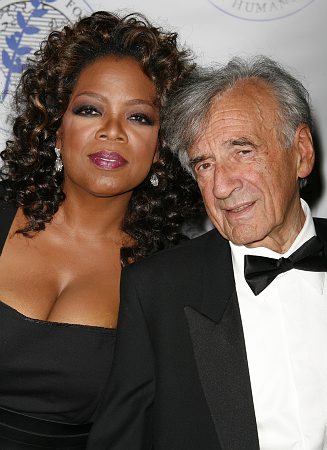 The sudden switch from fiction to non-fiction caused some discussion and questions, which Strand brushed away by saying, “Amazon.com’s data source for the Oprah Book Club edition of Night inaccurately classified the book as fiction.” She declined to offer details. The book, re-classified as “Autobiography” and blessed by Oprah, was already No.3 on Amazon.com as of that Tuesday afternoon! Wiesel, interviewed later with his literary agent Georges Borchardt, insisted they had never portrayed it as a novel.
The sudden switch from fiction to non-fiction caused some discussion and questions, which Strand brushed away by saying, “Amazon.com’s data source for the Oprah Book Club edition of Night inaccurately classified the book as fiction.” She declined to offer details. The book, re-classified as “Autobiography” and blessed by Oprah, was already No.3 on Amazon.com as of that Tuesday afternoon! Wiesel, interviewed later with his literary agent Georges Borchardt, insisted they had never portrayed it as a novel.
But the publisher did.1 There has been confusion about the question for so long—even Wiesel’s defenders have to admit it. Ruth Franklin, in her 2011 book, A Thousand Darknesses, wrote: “Unfortunately, Night is an imperfect ambassador for the infallibility of the memoir, owing to the fact that it has been treated very often as a novel—by journalists, by scholars, and even by its publishers.”2 On Night’s Wikipedia page it has long been described as autobiography, memoir, novel—yes, all three. How long will that continue? As long as there are editions of Night that still sport those labels, one assumes.
Left: Oprah Winfrey and Elie Wiesel pose together at the Elie Wiesel Foundation for Humanity Award Dinner at the Waldorf Astoria Hotel on May 20, 2007. Winfrey was honored with the Humanitarian Award for “positively impacting people all over the world, especially children.” One year earlier, she had selected Wiesel’s “Night” for her popular book club “pick” which sent it immediately to the top of the national bestseller lists.
As for Wiesel and Borchardt, they answered questions about differences in the text of the new edition by saying they were not significant enough to justify raising questions. The next day, Wiesel’s wife Marion, the translator of the new edition of Night, said in an interview that among the changes was a reference to the age of the book’s narrator when he arrives in 1944 at Birkenau, the entry point for Auschwitz.
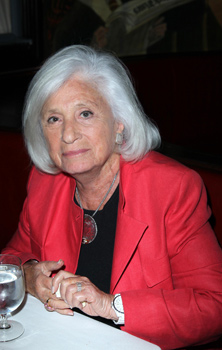 “At no point did this change the meaning and the fact of anything in the book,” Marion Wiesel said. She explained it this way: The narrator tells a fellow prisoner that he is “not quite 15.” But the scene takes place in Spring 1944. Mr. Wiesel, born on Sept. 30, 1928, would have already been 15, going on 16. So in the new edition, she changed it to “15.” Whaaaa? She changed the age of Eliezer as it was written in the Yiddish book to fit Elie Wiesel, who was fifteen and a half at that time. What is written in the Yiddish original, Un di velt hot geshvign, we also find in the original Night, so that can only be called unethical. Marion tried to joke it away, telling reporters “I kidded Elie and told him, ‘I don’t think you can add.'”
“At no point did this change the meaning and the fact of anything in the book,” Marion Wiesel said. She explained it this way: The narrator tells a fellow prisoner that he is “not quite 15.” But the scene takes place in Spring 1944. Mr. Wiesel, born on Sept. 30, 1928, would have already been 15, going on 16. So in the new edition, she changed it to “15.” Whaaaa? She changed the age of Eliezer as it was written in the Yiddish book to fit Elie Wiesel, who was fifteen and a half at that time. What is written in the Yiddish original, Un di velt hot geshvign, we also find in the original Night, so that can only be called unethical. Marion tried to joke it away, telling reporters “I kidded Elie and told him, ‘I don’t think you can add.'”
But that particular change, rather than insignificant, was one of the major reasons that a new translation was undertaken. There are other quite significant changes in the new edition that will be enumerated in this article. When you learn what they are, you can decide for yourself if you think they are insignificant.
Right: Marion Wiesel is the translator of the 2006 edition of Night. Here, in 2010, she attends an after party at The Monkey Bar for Oliver Stone’s new “South of the Border” New York premiere at Cinema 21.
Wiesel wrote a Preface to the New Translation, something he didn’t have in the original La Nuit or Night.
In his preface, Wiesel begins: “Why did I write it? … so as not to go mad or, on the contrary, to go mad in order to understand the nature of madness …”
He continues in this vein—typical Wiesel mystical-religious style. However, in his only description of the writing process of this book—the typing of the 862 pages which he titled Un di velt hot geshvign, according to his later memoir—it is hard to believe that he was in such a state of mind. He writes in All Rivers Run to the Sea that during this time in Paris he is busy with his newspaper job and contacts; also involved in a love affair with a woman named Hanna. He embarks on a major journalistic assignment in Brazil, sent by his editor, taking along a friend to keep him company on the ship’s crossing. They both get free tickets from a “resourceful Israeli friend”—these benefactors are usually unnamed. As the voyage begins, he says his mind is dwelling on Hanna and whether he should take the marriage step that she had asked for.
I can’t imagine an atmosphere less conducive to writing about what he describes as “the immense, terrifying madness that had erupted in history.” But he continues very matter-of-factly in All Rivers, “During the crossing I wrote my testimony …” and in one short paragraph tells us all he thought important to say about it. Moreover, he has never elaborated on it since!
In the new preface, Wiesel writes that in retrospect he doesn’t know what he wanted to achieve with his words, but then he comes up with something: “I knew that I must bear witness. I also knew that, while I had many things to say, I did not have the words to say them.” He needed to “invent a new language.” He is not speaking of an actual language, like German, French or English—but a language of survivors, or for survivors. Wiesel writes that common words like “hunger—thirst—fear—transport—selection—fire—chimney … all have intrinsic meaning, but in those times, they meant something else.” Really? He does not explain how that is so. But Wiesel has tried to create the idea of holocaust survivors as a special class, set apart, who know things others do not know, and can never understand—”Only those who experienced Auschwitz know what it was. Others will never know.”
Wiesel describes his writing as slow! “Writing in my mother tongue (Yiddish) … I would pause at every sentence, and start over and over again. I would conjure up other verbs, other images, other silent cries. It still was not right.” This contrasts totally with his description in his memoir All Rivers Run to the Sea (p. 238-40) that he wrote the original Yiddish manuscript fast and feverishly without re-reading!
Why a new translation of Night after 45 years of success with the old one?
Here again, Wiesel hedges in the preface and doesn’t have a convincing answer. He says his wife Marion has translated other books for him, and “knows his voice better than anyone else.” He says he didn’t pay enough attention to the original English translation by Stella Rodway—after his first reading of Night from the publisher, he never read it again. As for Mrs. Wiesel: “Fluent in French, she had never read the English version,” she said. But good news! Elie Wiesel Cons The World has found a translator and now has large portions of the Yiddish book translated into English. We can compare the real 245-page original to both the 1960 English translation from the French by Stella Rodway and the 2006 English translation done by Marion Wiesel.
In doing so, we have made two important discoveries.
First, Stella Rodway’s 1960 English translation of Night is an accurate rendition of the French text of La Nuit, as originally published in 1958. That means that if there are any “errors” in the Night story, they weren’t put there by Stella Rodway.
Second, when we compare the three texts—the original version of Night, as translated by Rodway, the “corrected” 2006 translation by Marion Wiesel, and the 1955 Yiddish original of Un di velt hot geshvign—we find that the “errors” brought up by Marion Wiesel are for the greater part what was actually written in the original Yiddish book, though usually in more detail there.
In other words, the 1955 Yiddish version, the 1958 French version, and the 1960 English version generally agree—only the “corrected” 2006 translation is different. So, are these really errors of translation that Marion Wiesel is fixing for us? Or are they not simply problems for Elie Wiesel? Under close scrutiny, the Elie Wiesel narrative has huge holes which bring up embarrassing questions, and this is what Marion Wiesel’s new translation was meant to head off.
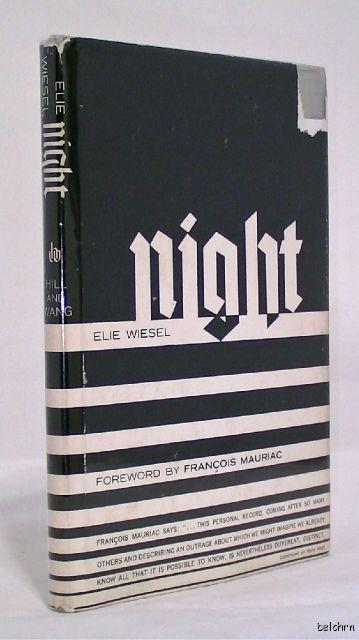
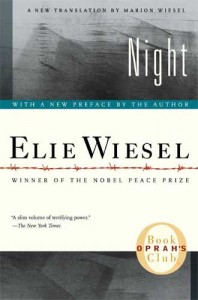
Left: Original Night cover, 1960, features the title, while the author’s name is exceptionally small and insignificant. Francois Mauriac’s forward is featured. In 2006, the author becomes the “title,” i.e. the main selling point, and Mauriac is no longer mentioned, although his forward remains in the book.
A Comparison of the 1960 original with the 2006 new version.
Following are the most “significant” differences I have found between the Stella Rodway 1960 translation and the Marion Wiesel 2006 translation. To make as clear a case as possible, I begin with the Yiddish [UdV] and its French translation La Nuit [LN], followed by the Stella Rodway English translation [SR]. Finally, Marion Wiesel’s revised translation [MW]. The word or phrase being compared is in boldface. Number one has already been written about in When Did Elie Wiesel Arrive at Auschwitz?
1. The Saturday before Pentecost … or two weeks before?
UdV Page 22: Geshen iz dos Shbth far Shbw’wth. A friling-zun hot oysgegosn ir likht un varemkeyt iber der gorer velt un oykh iber geto … / It happened Saturday [Sabbath] before Shavuot. The springtime sun had spread its light and warmth over the whole world, and even over the ghetto. . . .
LN Page 29: Le samedi précédant la Pentecôte, sous un soleil printanier, les gens se promenaient insouciants à travers les rues grouillantes de monde / The Saturday preceding Pentecost …
SR Page 23: On the Saturday before Pentecost, in the Spring sunshine, people strolled carefree and unheeding, through the swarming streets.
MW Page 12: Some two weeks before Shavuot (Pentecost). A sunny spring day, people strolled seemingly carefree through the crowded streets.
The Yiddish, the French and the original English versions agree—it was the Saturday before the festival of Pentecost/Shavuot—but Marion Wiesel’s new edition sets that date back by two whole weeks. This is very significant because, as the story continues, it was later on the following day that the Jews of Sighet were forced to leave their homes in preparation for their eventual deportation: “The ghetto was to be liquidated entirely. We were to leave street by street, starting the following day.”
So Mrs.Wiesel was NOT correcting errors in the English translation, but changing the text to fit the reality of when the Hungarians from Sighet arrived at Birkenau. Pentecost was on Sunday, May 28, 1944. The “Saturday before Pentecost” is thus May 27. Some two weeks before is May 14.
Un di velt hot geshvign, La Nuit and the Rodway translation all have Eliezer’s family leaving on the final journey to Auschwitz around June 2nd, six days after Pentecost/Shavuot, which was a Friday. However, they also agree that “Saturday, the day of rest, was chosen for our expulsion.” So it’s necessary for us to add another day to the family’s stay in the small ghetto to make the chronology work. On Saturday, then, the Jews are marched to the synagogue and spend the night there; in the morning, Sunday June 4, they board the train: “The following morning [Sunday], we marched to the station, where a convoy of cattle wagons was waiting. [… ] We were on our way.” Four days and three nights on the train (according to the description in Night) makes their arrival date June 6, 1944, around midnight.
But this is not only long after the prisoner number A7713—which Elie Wiesel supposedly received at Auschwitz, and still (again, supposedly!) has tattooed on his left arm—had been given out, but also long after the last transport left from Sighet. Indeed, there were no transports from the town after May, according to official records.
Marion Wiesel did not mention this one to the reporters; nor did Elie speak of it in his preface to his wife’s translation. But it was discovered by our translator. Marion Wiesel’s arbitrary “correction” allows Eliezer’s family to leave on May 21 and to arrive by May 24 (just before midnight!) thus making it possible for Eliezer to receive the registration number A7713. This is a very significant change, probably the most significant in her entire new English translation.
An added note: This interesting passage is on page 27 of Un di velt, but is not included in the shorter French or English Night:
We had opportunities and possibilities to hide with regular goyim and with prominent personalities. Many non-Jews from the surrounding villages had begged us, that we would come to them. There were bunkers available for us in villages or in the mountains. But we had cast aside all proposals. Why? Quite simple: the calendar showed April 1944 and we, the Jews of Sighet, still knew nothing about Treblinka, Buchenwald and Auschwitz.
Now we have April as the general time of deportation! So according to the timeline we find in Un di velt, Eliezer and his family left Sighet some time in June, while the calendar on their wall still said April . . . and in the meantime, we know from official Auschwitz records that the deportations actually occurred in the last two weeks of May. The person who wrote this knew nothing about the real deportation dates for the Sighet Jews.
2. Copulating on the train … or just caressing?
UdV Page 47: Tsulib der engshaft hobn a sakh instinktn zikh dervekt in kerper. Erotishe instinktn, un untern forhang fun der nakht hobn yungeleyt un froyen zikh gelozn bahersht durkh di oyfgereytste chwshym zeyere.
Ot der ershter rezultat fun umglik: erotishe freyheyt. Di shpanung fun di letste teg hot itst gezukht a veg vi oystsulodn zikh un der leychtster iz geven – an erotisher.
Di erotishe stsenes hobn nisht dervekt keyn protestn mtsd di eltere Yidn. Zey hobn farmakht oyern un oygn, zikh gemakht nisht zen un nisht hern. In moment fun schnh faln avek di keytn fun der konventsioneler moral. Mentshn hobn zikh getrakht: ver veys vos der morgn iz “lwl tsu brengen? Zol yugnt oysnutsn dem heynt, oystsapn fun im dem letstn hn’h-tropn . . .
In English: Because of the crowding, a host of instincts awoke in [people’s] bodies. Erotic instincts – and beneath the curtain of night young men and women let themselves be ruled by their aroused senses.
And so the first result of misfortune: erotic freedom. The stress of the last days now sought a way to discharge itself, and the easiest was – an erotic one.
The erotic scenes did not arouse any protests from the older Jews. They closed their ears and eyes, and forced themselves not to see and hear. In the moment of danger, the chains of conventional morality fall away. People thought to themselves: who knows what the morning is likely to bring? Youth must seize the day, squeeze from it the last drops of pleasure . . .
LN Page 45: Libérés de toute censure sociale, les jeunes se laissaient aller ouvertement à leurs instincts et à la faveur de la nuit, s’accouplaient au milieu de nous, sans se préoccuper de qui que ce fût, seuls dans le monde. Les autres faisaient semblant de ne rien voir.
SR Page 34: “Free from all social constraint, the young people gave way openly to instinct, taking advantage of the darkness to copulate in our midst, without caring about anyone else, as though they were alone in the world. The rest pretended not to notice anything.”
MW Page 23: “Freed of normal constraints, some of the young let go of their inhibitions and, under cover of darkness, caressed one another, without any thought of others, alone in the world. The others pretended not to notice.”
Elie Wiesel did not mention this change in his preface to the new English translation by his wife, but he did give quite a lengthy explanation (humorous to us) in the preface he wrote for the new French edition. This is what he said there:
Thanks to her, it was possible for me to correct an incorrect expression or impression here and there. An example: I describe the first night-time voyage in the sealed cars, and I mention that certain persons had taken advantage of the darkness to commit sexual acts. That’s false. In the Yiddish text, I say that “young boys and girls allowed themselves to be mastered by their excited erotic instincts.” I have checked among many absolutely trustworthy sources. In the train, all the families were still together. A few weeks of the ghetto could not have degraded our behavior to the point of violating customs, mores and ancient laws. That there may have been some clumsy touching, that is possible. But that was all. Nothing went any further. But then, why did I say that in Yiddish, and allow it to be translated into French and English? The only possible explanation: it is myself I am speaking of. It is myself that I condemn. I imagine that the adolescent that I was then, in the throes of puberty even if profoundly pious, could not resist such erotic imaginings, enriched by the physical proximity between men and women.
The original French : Grâce à elle, il me fut permis de corriger çà et là une expression ou une impression erronées. Exemple : j’évoque le premier voyage nocturne dans les wagons plombés et je mentionne que certaines personnes avaient profité de l’obscurité pour commettre des actes sexuels. C’est faux. Dans le texte yiddish je dis que « des jeunes garçons et filles se sont laissés maîtriser par leurs instincts érotiques excités. » J’ai vérifié auprès de plusieurs sources absolument sûres. Dans le train toutes les familles étaient encore réunies. Quelques semaines de ghetto n’ont pas pu dégrader notre comportement au point de violer coutumes, moeurs et lois anciennes. Qu’il y ait eu des attouchements maladroits, c’est possible. Ce fut tout. Nul n’est allé plus loin. Mais alors, pourquoi l’ai-je dit en yiddish et permis de le traduire en français et en anglais? La seule explication possible: c’est de moi-même que je parle. C’est moi-même que je condamne. J’imagine que l’adolescent que j’étais, en pleine puberté bien que profondément pieux, ne pouvait résister à l’imaginaire érotique enrichi par la proximité physique entre hommes et femmes.
Is this convincing, dear readers? Consider that the narrator of Un di velt says exactly the opposite of what Wiesel tries to present in his new French preface: the first result of a few weeks in the ghetto was erotic freedom, which was acted out in front of everyone in the train. And the “erotic instincts” that the youths let themselves be “ruled by” clearly must have involved sexual intercourse—why else would everyone have needed to shut their eyes and ears so tightly?
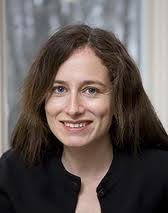
Liar Ruth Franklin
The Elie Wiesel of 2006 (and perhaps the Hasidic rebbes had something to do with this?) wants us to believe in the inviolable sanctity of the Jews’ “customs, mores and ancient laws,” and also in their innate respect for their elders and one another. But he is directly contradicted by what are, we are told, his own words of fifty years ago : “In the moment of danger, the chains of conventional morality fall away.” Which Wiesel do we believe?
And Ruth Franklin, senior editor at The New Republic, has the temerity to insist (toward the end of her 2006 review article) that “his [Elie’s] original suggestion that couples “copulated” in the cattle cars on the way to Auschwitz . . . was always a gross mistranslation of the original Yiddish.” We’ve shown you here that it isn’t.
3. Not yet fifteen … or fifteen?
UdV Page 63 : Yingl, vi alt bistu? fregt mir a heftling. Zeyn pnym iz geven in der fintster, ober zeyn kol iz geven a mids, a varems. Nokh nisht keyn 15 yor, hob ikh geentfert.
“Kid, how old are you?” a prisoner asked me. His face was in darkness, but his voice was tired and warm. “Not yet 15 years,” I answered.
LN Page 54: Hé, le gosse, quel âge as-tu? C’était un détenu qui m’interrogeait. Je ne voyais pas son visage, mais sa voix était lasse et chaude. “Pas encore quinze ans.” / Not yet 15 years.
SR Page 39: “Here, kid, how old are you?” It was one of the prisoners who asked me this. I could not see his face, but his voice was tense and weary. “I’m not quite fifteen yet.”
MW Page 30: “Hey, kid, how old are you?” The man interrogating me was an inmate. I could not see his face, but his voice was weary and warm. “Fifteen”
This very important passage was discussed above. I think the reader would agree that “not yet 15″ can mean even farther from the age of 15 than “not quite fifteen.” What is clear is that Marion Wiesel has changed the author’s original words to fit them to her husband’s age in Spring 1944.
4. April … or May?
UdV Page 83: A sheyner April-tog iz es geven. A frilings-rich in der luft. In English: It was a beautiful April day. A scent of spring in the air.
LN Page 69: C’était une belle journee d’avril. Des parfums de printemps flottaient dans l’air. Le soleil baissait vers l’ouest.
SR Page 49: It was a beautiful April day. The fragrance of spring was in the air. The sun was setting in the west.
MW Page 40: It was a beautiful day in May. The fragrances of spring were in the air. The sun was setting.
(See again When Did Wiesel Arrive) Once more, the original Night as translated by Stella Rodway agrees with the Yiddish and the French; Marion Wiesel arbitrarily changed April to May, yet said her translation did not “change the meaning or the fact of anything in the book” … what she calls a “significant change.” Well, this is a significant change, and for the same reason as given in number 1 above.
5. Himmler … or “Reichsfuehrer Himmler?”
UdV Page 124-5: “In nomen fun Himler . . . der heftling num’ . . . hot gegnbet . . . bsh”thn luft-alarm . . . loytn gezets, paragraf . . . iz der heftling num’ . . . farurteylt tsum toyt! Zol dos zeyn a lere un a beyshpil far ale heftlingen . . .”
“In the name of Himmler . . . prisoner number . . . stole . . . during the air raid . . . according to the law, paragraph . . . prisoner number . . . is condemned to death. May this be a lesson and an example for all prisoners.”
LN Page 100: “Au nom de Himmler ... Le détenu No… a dérobé pendant l’alerte… “
SR Page 68: “In the name of Himmler … prisoner Number … stole during the alert … According to the law … paragraph …prisoner Number … is condemned to death. May this be a warning and an example to all prisoners.”
MW Page 62: “In the name of Reichsfuehrer Himmler … prisoner number … stole during the air raid … according to the law … prisoner number … is condemned to death. Let this be a warning …..”
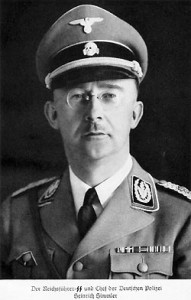
Reichsfuehrer SS Heinrich Himmler
Again, the Yiddish and the original Night agree. However, no trained member of the SS, or even the Wehrmacht, would ever have shown such disrespect as to use Himmler’s name in such a formal context without his full title: Reichsfuehrer SS Heinrich Himmler. Marion Wiesel tried to fix the error by adding “Reichsfuehrer,” but she still gets it wrong: you don’t drop the “SS.” On its own, this tells us that the speech was an imaginary one invented by the author (whoever that is), someone who was never present at such a scene. Indeed, lack of knowledge about how the SS functioned in the camps is evident throughout the book. For example, the SS did not normally go inside the barracks; everything inside was handled by the kapos.
6. Ten days and ten nights … or just “days and nights”
UdV Page 207: Tsen teg un tsen nekht hot gedoyert di reyze. / Ten days and ten nights the trip lasted.
LN Page 155: Dix jours, dix nuits de voyage. Il nous arrivait de traverser des localités allemandes.
SR Page101: Ten days, ten nights of traveling. Sometimes we would pass through German townships.
MW Page 100: There followed days and nights of traveling. Occasionally we would pass through German towns.
In January of 1945, as the advancing Red Army approached Auschwitz, a decision was made to evacuate, sending the prisoners to other camps in Germany. Evacuation of the Monowitz (Auschwitz III) camp, to which Eliezer and Father had previously been transferred, began at 6 p.m. on January 18. The prisoners were given extra clothing and food—bread to carry with them. They also had whatever food they had saved up. After marching all night during a snowfall, they rested in the morning in an old brick factory. In late afternoon, they began again and reached Gleiwitz camp in a few hours [night, Jan. 19]; they then remained in Gleiwitz barracks for three days. On the 22nd they went to the train stop and waited until evening. They were brought bread for the journey. The convoy set out
From there, as we see above, the Yiddish, the 1958 French and 1960 English versions agree on the trip lasting ten days and nights. But Marion Wiesel removes the number ten because it makes Eliezer’s timeline for the death of his father on Jan. 28/29 completely impossible. Another very significant change. Ten days and nights from the night of Jan. 22nd is the night of Feb 1, 1945.
This shows that the author of Un di velt knew nothing about the transport that arrived at Buchenwald on January 26 with 3000 prisoners from Auschwitz. This is the transport that, according to existing official records, brought Lazar and Abraham Wiesel to Buchenwald, who were registered at the camp there on . . . January 26, 1945! (See Buchenwald Archivist Cannot ID Elie Wiesel, How True to Life is Wiesel’s description of Buchenwald, and Gigantic Fraud Carried Out.)
7. Fifteen … or sixteen?
UdV Page 213: I was fifteen years old then. Do you understand—fifteen? Is it any wonder that I, along with my generation, do not believe either in God or in man; in the feelings of a son, in the love of a father. Is it any Wonder that I cannot realize that I myself experienced this thing, that my childish eyes had witnessed it? (This passage from Moshe Spiegel’s stand-alone translation of Chapter Six of Un di velt hot geshvign, published as “The Death Train” in the 1968 volume Anthology of Holocaust Literature.)
LN Page 158: J’avais quinze ans. / I was fifteen.
SR Page 103: I was fifteen years old.
MW Page 102: I was sixteen.
In the original versions, Eliezer repeats that he is fifteen years old in January 1945. Elie Wiesel’s birth date is Sept. 30, 1928 so on that day in 1944 he became sixteen years old, making him 16 years and 4 months when this particular event on the train to Buchenwald occurred in late January 1945. Once again, Marion Wiesel simply changes the age as she did before — if Elie was actually sixteen at that time, then Eliezer, the character in the book, must be too!
In Part Two, I will construct the timeline of the events in Buchenwald following the arrival of Eliezer and his father, and other details about Buchenwald. What will we find out? Stay tuned.
Endnotes:
1. On the back cover of the original hardcover Night, with the black & white striped jacket (as pictured here), it is printed “Literature” as the classification.
2. Ruth Franklin, A Thousand Darknesses: Lies and Truth in Holocaust Fiction, Oxford University Press, 2011, pp 71-72.
Unfortunately, Night is an imperfect ambassador for the infallibility of the memoir, owing to the fact that it has been treated very often as a novel—by journalists, by scholars, and even by its publishers. Lawrence Langer, in his landmark study The Holocaust and the Literary Imagination, notes that Night “continues to be classified and critically acclaimed as a novel, and not without reason.” . . .
Nonetheless, in 1997 Publishers Weekly columnist Paul Nathan had to issue a correction apologizing for referring to the book as an “autobiographical novel”; he had been misled, he said, by the entry on Wiesel in The International Dictionary of Twentieth-Century Biography. In response, the correction itself was challenged by the director of Penguin Reference Books, publishers of the biography dictionary, who cited half a dozen sources to the effect that Night was in fact a novel. Together with most critics, Gary Weissman, who recounted the above history in his book Fantasies of Witnessing: Postwar Efforts to Experience the Holocaust, seems to concur with Ernst Pawel’s remark in an early magazine survey of Holocaust fiction, that “the line between fact and fiction, tenuous at best, tends to vanish altogether in autobiographical novels such as Night.” The hybrid terms used to describe it include “novel/autobiography,” “non-fictional novel,” “semi-fictional memoir,” “fictional-autobiographical memoir,” “fictionalized autobiographical memoir,” and “memoir-novel.
GO TO PART TWO
19 Comments
Category Featured | Tags: Tags: Auschwitz-Birkenau, Buchenwald, Elie Wiesel, Holocaust fraud, Marion Wiesel, Monowitz, Night, Oprah Winfrey, Ruth Franklin, Un di velt hot geshvign,
Social Networks: Facebook, Twitter, Google Bookmarks, del.icio.us, StumbleUpon, Digg, Reddit, Posterous.











































